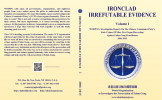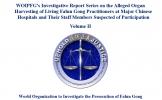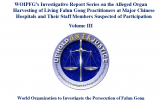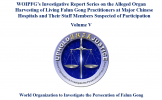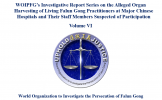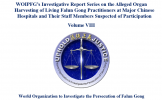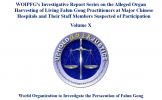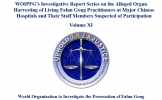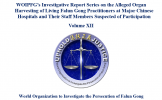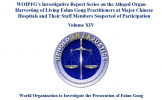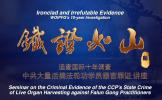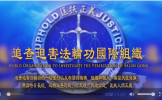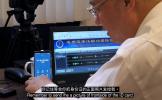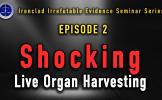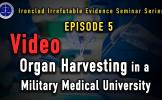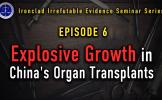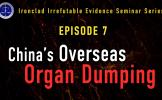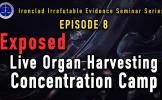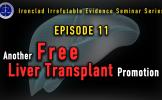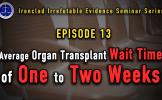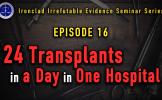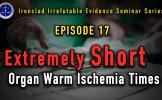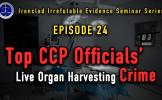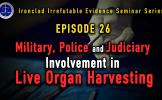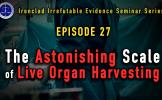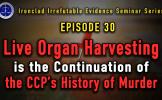Evidence of Live Organ Harvesting of Falun Gong Practitioners Collected from Chinese Medical Papers
Foreword
1 Brain Death, a justification to describe “donors” when organs were extracted
1.1 Brain Death vs. Cardiac Death
1.2 Most Organs Harvested from Cardiac Death Cases are Not Transplantable
1.3 Harvesting Organs from Brain Dead Persons is Illegal, According to Chinese Law
2 Intubation Time Indicates the “Donor” was not Brain Dead
2.1 First Affiliated Hospital Sun Yat-Sen University: Intubation after Brain Death
2.2 Jiangsu Province Zhenjiang No.1 People’s Hospital: Intubation After Acute Brain Death
2.3 Yunnan Province Kunming Yan’an Hospital: Intubation after Brain Death
2.4 Fujian Medical University Affiliated Xiehe Hospital: Intubation after Brain Death
2.5 Nanjing Military Region Fuzhou General Hospital: Intubation after Brain Death
3 Cause of Death Analysis Shows Most Donors were Alive at the Time of Organ Removal
3.1 Extremely Low Donation Numbers in China
3.2 Over Half of the “Donor” Cause of Death was “Brain Death”
3.3 Chinese Media Reports Indicate almost no “Brain-Dead Donors” Prior to July 2006
3.4 Suspiciously Similar Descriptions of Cornea Donors
4 Extremely Short Warm Ischemia Time: Sign of Living “Donors”
4.1 Majority of Research Papers Report Warm Ischemia Time to be Less Than 10 Minutes
4.2 First Affiliated Hospital Wenzhou Medical College: Zero Warm Ischemia Time in Heart Removal
4.3 Wuxi No.2 People’s Hospital: Zero Warm Ischemia Time in Liver Transplant
4.4 Nanfang Hospital: Zero Warm Ischemia Time in Heart Removal
4.5 More Examples of Short Warm Ischemia Time
5 “Donors” were Mostly Young Healthy Male
5.1 Absolute Majority of “Donors” were Male
5.2 Absolute Majority of “Donors” were under 40 Years of Age
5.3 “Donors” in perfect health, unlike regular prison population
6 Tissue Typing Labs Established after 2000
6.1 Examples of Tissue Typing Labs Established after 2000
6.2 Forensic Pathology Key Laboratory: Operated by Ministry of Health, Ministry of Public Security and the Supreme People’s Court
7 China’s Transplantation Abnormalities Indicate the Presence of Living Donor Organ Banks
7.1 Henan Armed Police Corps Hospital: Transplants after Live Organ Harvesting
7.2 The Second Affiliated Hospital of Harbin Medical University: Dedicated Heart Extraction Team
7.3 Xijing Hospital Shaanxi Province: Living “Donor” in Heart-Lung Transplant
7.4 PLA No.281 Hospital: Matching Kidney in One Day
7.5 Xi'an Gaoxin Hospital: “cramping in an old and beaten-down van to extract organs”
7.6 Emergency Transplant and Transplant with Preselected Date Rampant across China
7.7 Multiple Transplants Performed Consecutively or Simultaneously
8 Organ Harvesting Happens Throughout China
8.1 Organ Harvesting not Limited by Region, Happens in All Provinces
8.2 Focusing on Tianjin No. 1 Central Hospital: Annual Average 600 liver transplants
8.3 Many Hospitals Conducted Large Numbers of Organ Extractions
8.4 Suspicious connection: Dongguan Taiping People’s Hospital, Kunming Kidney Hospital and Kunming Forensic Hospital
8.5 Military and Armed Police Forces Hospitals Have Ample Organs, so Many They Even Provide Organs to Local Hospitals
8.6 The Peak of Organ Extractions Coincides with the Peak of the Persecution of Falun Gong
8.7 The Case of Weifang City Shandong Province: Intensifying Persecution and Thriving Transplantation Business
9 Transplant Abnormalities Continue in China
9.1 Qingdao University Founded an Organ Transplant Center and “Planned to Complete 100 Operations within the First Year”
9.2 Five donor livers “Simultaneously Arrived” at the Fuzhou General Hospital of Nanjing Military Region; Transplant Operations were Completed within 17 Hours
Conclusion
References
Index of Tables
Table 1.Suspiciously Similar Descriptions of Cornea “Donors”: “Sudden Death, Young Adults”
Table 2. Examples of Extremely Short Warm Ischemia Time.
Table 3. Examples of “Donors” with Perfect Health
Table 4. Hospitals with Large Numbers of Transplants
Foreword
Organ procurement is a deciding factor in the number and success rate of organ transplants. It is an open secret that Chinese regime has been harvesting organs from executed prisoners. Trips to the execution grounds to remove organs from executed prisoners are routine operation for medical personnel in China. However, because of the inferior health condition of executed prisoners, the extracted organs are not of high quality, thus organ transplantation in China had been limited. China’s former vice Minister of Health, Huang Jiefu, also admitted that the number of executed prisoners has been decreasing every year[1]. Started in 2000, however, rapidly increasing numbers of organs were extracted for transplant by hospitals of all sizes throughout the country. In the meantime, there was an increase in medical research papers about organ extraction and transplantation published in various Chinese medical journals. These papers provide details about organ transplantation and extraction, which Chinese officials' public speeches and state-run media failed to provide.
The series of investigative reports and evidence collected by WOIPFG, independent investigative report Bloody Harvest (2006) by Canadian Human Rights lawyer David Matas and former Canadian Secretary of State David Kilgour, State Organs: Transplant Abuse in China (2012) by internationally renowned medical professionals, and The Slaughter (2014) by author Ethan Gutmann, all reached the same conclusion that the main source of transplant organs in China since 2000 have been captive Falun Gong practitioners. China’s explosive increase of organ transplant surgeries coincides with the Chinese regime’s genocidal persecution of Falun Gong. The above mentioned investigative reports proved, from various angles, that China’s “thriving” transplantation industry has been entirely built upon the persecution of Falun Gong.
WOIPFG analyzed over 300 medical research papers from over 200 hospitals in 31 provinces and municipalities in China. We have discovered that the descriptions about “donors” sex, age, health condition and cause of death, the procedure of organ removal, the data on organ’s warm ischemia time and cold ischemia time, and the timing when transplantations were conducted, prove the existence of large organ “donors” banks consisting of living persons. This new set of evidence also strengthens the previous conclusion of harvesting organs from living persons by the Chinese regime is real, and that very large numbers of captive and healthy Falun Gong practitioners were kept as living “donors.” From 2000 to 2008, in particular, huge numbers of Falun Gong practitioners were killed on demand for their organs.
The medical papers obtained by WOIPFG are mostly published between 2000 and 2012. Not every organ extraction and organ transplant is published; especially those failed operations were not even recorded. Besides, the research papers collected by WOIPFG are only a small portion of all published papers. What is presented in this investigative report is still the tip of the iceberg.
Alongside this report, WOIPFG also releases the first batch of names of medical personnel, whose involvements in the live organ harvesting are being investigated.
1. Brain Death, a justification to describe “donors” when organs were extracted
WOIPFG analyzed a number of medical papers and discovered the majority of the papers use “brain death donors” when referring to the person whose organs were extracted. When performed under the rule and regulations, taking organs from brain-dead donors is widely recognized and legalized internationally. However, China has no brain death legislation, nor a functioning organ donation system. Therefore, the concept of “brain-dead donors” does not legally exist in China.
1.1 Brain Death vs. Cardiac Death
Death is traditionally defined as the heart stops beating, the breathing stops and the blood circulation stops. It is referred to as the cardiac death. Brain death refers to complete and irreversible loss of brain function.
China lacks the state issued official guidelines to diagnose brain death. In 2003, the Ministry of Health drafted “Brain Death Determination Criteria (Adult) (The Exposure Draft)”and “Brain Death Determination Technical Specifications (Adult) (The Exposure Draft).” They were published in Chinese Medical Journal (CMJ) and other major Chinese medical publications.
In 2009, the Ministry of Health revised the two documents and issued “Brain Death Determination Criteria (Adult) (Revised)”and “Brain Death Determination Technical Specifications (Adult) (Revised)[2].”
In March 2012, the Ministry of Health (now changed name to National Health and Family Planning Commission of PRC) assigned Xuanwu Hospital of Capital Medical University (in Beijing) as the Brain Injury Quality Control Evaluation Center. In 2013, the Center further revised and combined the two documents into“Brain Death Determination Criteria and Technical Specification (Adult Quality Control Version).”It was published in Chinese Journal of Neurology[3].
Strictly speaking, this Criteria and Technical Specification is merely a suggested medical standard. It is not even an administrative regulation, not to mention having any legal bindings. The official website of the National Health and Family Planning Commission does not have this Specification listed in its policy and regulation section. The Brain Injury Quality Control Evaluation Center is not listed as an affiliated member of the National Health and Family Planning Commission[4].
The document specifies three criteria of brain death, which are deep (irreversible) coma, absence of brain stem reflexes, and absence of spontaneous respirations.
1.2 Most Organs Harvested from Cardiac Death Cases are Not Transplantable
Warm Ischemia Time is the period of time from a donor’s death to perfusion of the organ. Cold solutions are used in order to preserve the organ after removal and prior to transplantation. Cold Ischemia Time is the period of time from perfusion to transplantation[5]. The cold ischemia time could include time to transport the organ, selection of recipient, and the actual time of the transplant surgery.
Organs with prolonged Warm Ischemia Time are not transplantable. In case of death in an accident, it is most difficult to control the Warm Ischemia Time. In mainland China, medical personnel go to the execution grounds to retrieve organs from prisoners is to ensure the Warm Ischemia Time is short. If the bodies of executed prisoners were to be transported to the hospital to have their organs harvested, the Warm Ischemia Time would be too long and the organs would not be transplantable.
Chinese transplantation field has been facing the dilemma that cadaveric organs are not transplantable, and that there is no legally binding documents on the diagnosis of brain death. Director of Zhejiang Province Ningbo City Transplant Center, Lu Caide was quoted in an article saying, “Our country’s definition of death is cardiac death. But when the heart fails, the lung will follow. These 2 organs require very short Warm Ischemia Time, and the transplantation surgery itself is very complicated[6].”
Director of the Kidney Transplant Center at Beijing Chaoyang Hospital, Zhang Xiaodong said, “When the heart stops beating, the circulation stops. This causes organs to fail. Even if people agree to donate organs after death, the organs would not be useful because of prolonged Warm Ischemia Time. The tolerable Warm Ischemia Time for different organs are, heart: 3-4min; liver: 5-8min; Kidney: 30min; cornea: 24hours. If a person is considered dead at the time of brain death, then the heart, lung, kidneys and liver would not be damaged and are transplantable[7].”
Taking organs from living donors results in short Warm Ischemia Time. The organ most commonly given by a living donor is the kidney. The Warm Ischemia Time can be as short as zero minute.
1.3 Harvesting Organs from Brain Dead Persons is Illegal, According to Chinese Law
On May 4, 2004, Ministry of Health issued a statement. It states that brain death is one way to define death by the medical community, and it differs from the currently adopted standard and definition. It also states that without proper laws and regulations in place, establishing the criteria for diagnosis and technical specifications of brain death does not mean diagnosing brain death is legal[8].
On Aug. 13, 2005, Xinhua published an article saying that among countries capable of transplantation, China is the only country without brain death regulation[9]. An Aug. 22, 2014 article on qq.com titled “No brain death regulation in China, 90% of doctors are not clear about the specifications either” says there are 80 countries in the world that have brain death regulations, but not China[10].
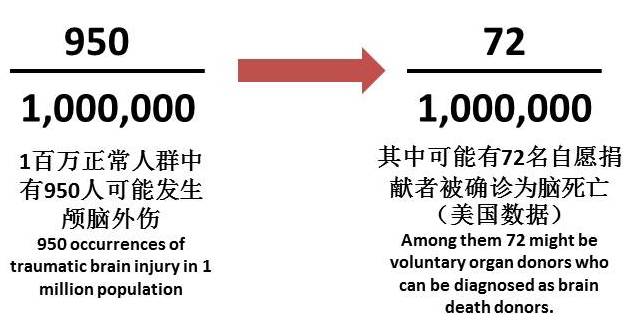
In 2004, Chen Zhonghua, director of the Institute of Organ Transplantations at Tongji Hospital, Wuhan city, Hubei province, published a paper about brain death[11]. Chen wrote, “Primary brain death is very rare. It is caused by traumatic brain injury and intracranial lesions. On an average, there are about 95 cases of traumatic brain injuries in every 100,000 people. Among the 95 cases, some would die before reaching the hospital. Some would receive treatment in the hospital, and could have 3 possible outcomes: (1) survived; (2) cardiac death; (3) brain damaged, but heart beat and breathing can be maintained by ventilator and drugs. Only the 3rd outcome is eligible for brain death diagnosis, if they were voluntary organ donors. Therefore, the ‘brain-dead donors’ are extremely rare.” Chen continues to say that “in America, 72 out of 1 million persons are organ donors eligible for brain death diagnose for transplant purposes.” In China, “brain-dead donors” simply do not exist.
However, in Chinese medical papers, “brain-dead donors” is commonly used to describe the organ sources. They could come from the 95 cases out of 100,000 people described in Chen Zhonghua’s paper, but only a very limited amount. Then, there must be another group of “donors” who were labeled “brain-dead.” This group of people is the main source of organs in China. Based on the annual transplant numbers in China, this must be a very large group of people.
In his paper, Chen admits that China has no brain death regulation. But he also presented an argument, namely, because China has no regulation to either legalize or ban brain death diagnosis, therefore, using organs from brain dead persons is, “strictly speaking, not illegal.”
Using the same logic, China does not ban harvesting organs from prisoners of conscience, so harvesting organs from prisoners of conscience is, strictly speaking, not illegal? In addition, Chen’s claim is against the Ministry of Health statement issued in 2004.
As of Sept. 2014 when this report was written, China still has no brain death regulation. Therefore, harvesting organs from brain dead persons is illegal in China. Even if China announces the regulation in the future, it cannot negate the illegality of all organ harvesting activities before the regulation is enacted.
2 Intubation Time Indicates the “Donor” was not Brain Dead
As described earlier, the three criteria of brain death are deep (irreversible) coma, absence of brain stem reflexes and absence of spontaneous breathing. The apnea test must be performed to determine the existence of spontaneous breathing or lack of it. Apnea test requires turning off the ventilator for 8 to 10 minutes.
That is to say, to be diagnosed brain dead, one must have already been connected to a ventilator through intubation. But in many Chinese medical research papers, the procedure of organ removal starts with intubation, after the diagnosis of brain death. Here are some examples.
2.1First Affiliated Hospital Sun Yat-Sen University: Intubation after Brain Death
In the 2 combined heart lung transplantation performed in 2006 at the First Affiliated Hospital, Sun Yat-Sen University, the “donors were both male, ages 28 and 32, both were diagnosed brain-dead, no cardiovascular diseases, and no infectious diseases[12].”

The steps to remove the heart and lung began with “anesthesia preoperative treatment.” It reads:
|
2.2.1 Anesthesia preoperative treatment: In order to decrease the Warm Ischemia Time of heart and lung, the nurse quickly opens up the venous passage, put the donor’s body in place (lie flat on back, upper limbs secured on the sides). The nurse helps the anesthetist to perform branch fiber endoscopy and then intubation. |
If the “male donors” were “both diagnosed brain dead,” then they must have had intubation and ventilators connected. But the procedure described above suggests that at the time of diagnosed “brain death,” the “donors” were not intubated.
2.2 Jiangsu Province Zhenjiang No.1 People’s Hospital: Intubation After Acute Brain Death
A research paper described 4 heart transplants performed at Zhenjiang No.1 People’s Hospital from April 2005 to December 2006. “The donors were all male, ages 23 to 40, acute brain death donors[13].”

The first step was to “rapidly perform intubation after acute brain death, suck out the secretions from the respiratory tract, and ventilate with pure oxygen.”

2.3 Yunnan Province Kunming Yan’an Hospital: Intubation after Brain Death
Kunming Yan’an Hospital’s paper (submission date: Jan. 2013) described 7 heart transplants performed since April 2003. All 7 “donors” were “male brain-dead donors who agreed to donate organs before death[14].”

The Chinese regime’s official media reported the “first brain-dead voluntary organ donor” in July 2006[15]. The research paper said that the 7 heart transplants were performed as early as April 2003. How did Yan’an Hospital in Kunming, Yunnan province find “brain-dead voluntary organ donors” since 2003?
The paper’s submission date was Jan. 2013, when the regime was boosting the ‘effectiveness’ of the new donation system. Very likely, ‘agreed to donate’ became the new set phrase in medical papers.
The procedure to remove all 7 hearts started with “intubation after brain death”.

2.4 Fujian Medical University Affiliated Xiehe Hospital: Intubation after Brain Death
A research paper described 4 combined heart lung transplantations performed at Fujian Medical University Affiliated Xiehe Hospital between Dec. 2004 and early 2007. The procedure of heart-lung removal states, “all donors were brain dead, apply intubation, cut open the chest, heparinize, and remove the pericardium …[16]”
2.5 Nanjing Military Region Fuzhou General Hospital: Intubation after Brain Death
A paper from Nanjing Military Region Fuzhou General Hospital described 5 heart transplants performed since April 2004. “The 5 donors were male. After brain death, they were intubated to maintain breathing and circulation, they were heparinized, then the aorta was cut…[17]”
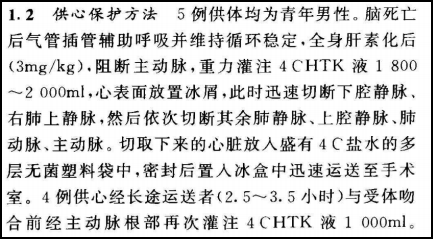
The few examples here show the first step of removing organs was to pronounce someone “brain-dead” without performing the apnea test, which requires intubation and a ventilator. The intubation happened after the person was pronounced “brain-dead”. This shows that “brain death” is merely an excuse, while the “donor” was very likely alive at the time of organ removal.
3 Cause of Death Analysis Shows Most Donors were Alive at the Time of Organ Removal
3.1 Extremely Low Donation Numbers in China
According to Family Health Newspaper, a subsidiary of China’s state-run Heilongjiang Daily, the number of “citizens donation after death” was zero in 2003, 22 in 2006 and “as of Nov. 20, 2008, the number finally reached 104[18].”
According to China Red Cross, from March 2010 to March 2012, the Organ Donation Trial Project only persuaded 207 people to donate their organs after they die. Most of them were from poor rural areas, and 90% of the potential donors or their family members asked to be “financially compensated[19].”
The donation number in China is too small to be considered as a source of organs in transplantation in China. In Chinese medical papers, “donor” is a very commonly used word. “Voluntary donation” is occasionally used. Along with “brain death”, these words have lost their original meanings.
3.2 Over Half of the “Donor” Cause of Death was “Brain Death”
WOIPFG analyzed the causes of “donors’ death” described in 100 Chinese medical research papers. The organs extracted included hearts, lungs, livers, kidneys, and corneas. There are 6 different causes of death as described: “brain death,” “traumatic brain injury,” “heart just stopped beating,” “no heart beat,” “cadaver” and “sudden death.” The chart below shows the ratio. Further analysis of these causes concludes that the “donors” were most likely alive at the time of organ removal.
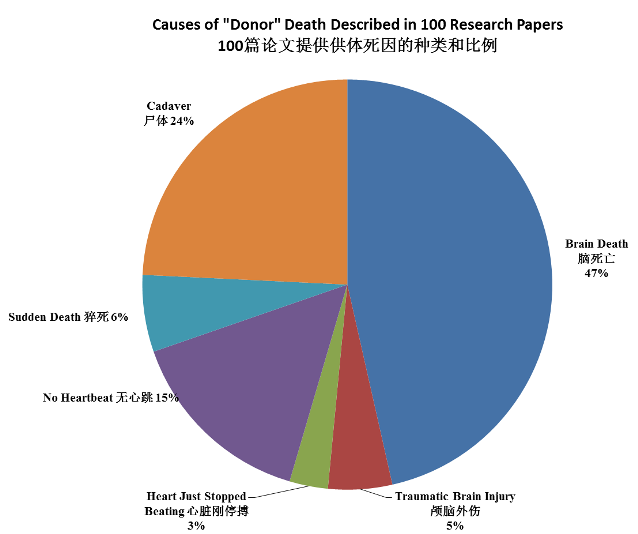
The first category for causes of death is “heart just stopped beating” and “no heart beat,” which makes up approximately 18% of the “donors” discussed in the medical papers. Why wasn’t “cardiac death” used? This is because cardiac death organs are not transplantable because of the prolonged warm ischemia time. Yet “no heart beat” and “heart just stopped beating” have the connotation that the transition from beating-heart “donor” to non-beating-heart “donor” was arbitrary, controlled and premeditated.
The second category for causes of death is “cadaver” and “sudden death,” which makes up approximately 30% of the “donors” discussed in the medical papers. Strictly speaking, the cause and time of death of a cadaver or sudden death is not clear. However, almost all organs extracted from these “donors” have warm ischemia time of less than 10 minutes. The short warm ischemia time indicates that the cadavers were all fresh and that in less than 10 minutes after death, the organs were already removed. The question is how the “fresh cadavers” and “sudden death cadavers” ended up on an operating table for organ removal in such short period of time. The only explanation is that the deaths were “expected” and the organ removal personnel had advanced notice that there would be “fresh cadavers” available.
The third category for causes of death is “brain death” and “traumatic brain injury,” which makes up approximately 51% of the “donors” discussed in the medical papers. Without brain death regulation, over half of the “donors” died of brain death, this by itself is implausible. Moreover, analysis in section II indicates that the so-called brain death persons were not intubated, were not on ventilators and apnea testing was not performed. The “donors” might not really be brain dead, or they were arbitrarily put into “brain dead” state.
A focused analysis of heart transplant research papers from 45 hospitals in China was done. This group of heart transplants was performed prior to March 2009. Among all the “donor” hearts, 685 cases (78%) were from so-called “brain dead” persons, 186 cases (21%) had no specified sources, and 5 cases (1%) were from “cadavers.” Moreover, the 5 cadaver hearts happened to come from the same paper by Liaoning province Dalian University Affiliated Hospital. From January to June 2005, Dalian University Affiliated Hospital obtained 5 “cadaver” hearts for transplant. “The cadavers were male, ages 24 to 46. The warm ischemia time was 2 to 6 minutes; the cold ischemia time was 112 to 235 minutes[20].” The warm ischemia time suggests that within 2 to 6 minutes after death, the hearts were already extracted from the cadavers. The cadavers were most likely living prior to heart extraction. The cold ischemia time suggests that within 2 to 4 hours, the hearts were transplanted. This indicates that the organ extraction and transplantation were mostly likely performed at the same location.
The July 2010 edition of Organ Transplantation, supervised by the Ministry of Education, claims that “since 2001, under the guidance of Dr. Chen Zhonghua and his team to fight for donation after brain death, there have been over 60 organ donations after brain death in the entire country[21].” However, WOIPFG’s small scale focused analysis of papers from 45 hospitals shows at least 685 hearts harvested. This number is already far greater than the official number.
To summarize, the terminologies used by the medical papers to describe causes of death are used to hide the true source of organs, their medical meaning has been lost.
3.3 Chinese Media Reports Indicate almost no “Brain-Dead Donors” Prior to July 2006
On July 11, 2006, People’s Daily published an article titled “Our country’s first donation heart transplant was successful.” The article stated “On July 1, 2006, the 18th brain dead donor donated a heart. The transplant surgery was successful. This is the first successful case of heart transplant using a brain dead donor.” The article also quoted Dr. Chen Zhonghua saying, “by far there are 18 cases of successful brain death organ donation in China[22].”
On July 25, 2006, Yangcheng Evening News published an article titled “First brain dead donor lung transplant successful.” The article stated “the first lung transplant from a brain dead donor was successfully carried out in Shenzhen People’s Hospital on July 19, 2006… There are about 100 such operations in the country and only 4 in Guangdong province.” The article also quoted Chen Zhonghua saying, “the lung was from Ms. Yang, a 39 year old female brain dead donor, who wished to donate her heart, liver, kidneys, lung, and cornea. She is the first voluntary brain dead organ donor in our country[23].”
These two state-run media reports indicate:
- Prior to Ms. Yang, all brain dead “donors” were involuntary.
- The 17 other brain dead “donor” organs prior to July 1, 2006 were either not heart, or failed in transplantation. So all medical papers prior to July 1, 2006 that described successful transplantation using brain dead “donor” organs were in fact, either “living donor organs” or harvested without consent from “donor” or family member.
That is to say, the Chinese state controlled media proved the non-existence of “brain dead donors.”
3.4 Suspiciously Similar Descriptions of Cornea Donors
In China, no matter how big or small a hospital is, as long as it performs corneal transplant, the corneal grafts are “fresh.” Medical papers on corneal transplant use surprisingly similar phrases to describe the “donors.” The most frequently used words are “sudden death” and “young adults.” The corneas were usually harvested within 10 minutes to several hours after death. The transplants happened within 10 to 24 hours. The table below gives some examples.
Table 1.Suspiciously Similar Descriptions of Cornea “Donors”: “Sudden Death, Young Adults”
|
Hospital Name |
Time Period of Transplants |
No. of Corneal Transplants |
Description of “Donors” |
|
|
1 |
北京市监狱管理局中心医院和北京同仁眼科中心 Central Hospital of Beijing Prison Administration Bureau & Beijing Tongren Hospital Eye Center |
1993 - 2005 |
27 cases (30 eyes) |
死亡青壮年男性[24] Deceased young adult male. |
|
2 |
广州眼库 |
No description of time when transplant took place. The paper was submitted in Feb. 2002. |
45 cases |
供体死因均为猝死,年龄20-43岁,平均30.4 +/-5.4岁,摘除供眼时间为死后30min到3h[25] “Donors” died of sudden death, age 20-43, average age is 30.4/-5.4. Donor eye was removed 30 minutes to 3 hours after death. |
|
3 |
青海大学附属医院眼科 Qinghai University Affiliated Hospital |
2000/5 - 2004 |
13 cases |
供体为猝死的青壮年[26] “Donors” were young adults died of sudden death. |
|
4 |
贵州省遵义医学院附属医院眼科 Affiliated Hospital of Zunyi Medical College, Guizhou Province |
2000/3- 2001/7 |
10 cases |
供体为健康青年人的新鲜角膜,从供体死亡到角膜移植手术时间不超过10小时[27] “Donors” were healthy young people, corneas were fresh, time between donors’ deaths and corneal transplants were less than 10 hours. |
|
5 |
云南省昆明市第一人民医院眼科 Kunming No.1 People’s Hospital, Yunnan province |
2006/6 - 2009/11 |
73 cases |
供体为猝死的健康青年[28] “Donors” were young healthy persons died of sudden death. |
|
6 |
黑龙江省牡丹江医学院红旗医院眼科 Mudanjiang Medical College Hongqi Hospital, Heilongjiang province |
Until 2009 |
34 cases (36 eyes) |
供体均为非正常死亡的健康青年,年龄在18~40岁。均为男性[29] “Donors” were all healthy young people died of unnatural deaths, ages ranged from 18 to 40, all were male. |
|
7 |
浙江省宁波市眼科医院 Ningbo Eye Hospital, Zhejiang province |
2001/2 – 2002/12 |
13 cases (18 eyes) |
供体为猝死青壮年尸眼[30] Cadaver’s corneas were from young adults died of sudden death. |
|
9 |
海南医学院附属医院和海南省人民医院 The Affiliated Hospital of Hainan Medical College and Hainan Province People’s Hospital |
2004/1- 2009/12 |
43 cases |
供体年龄19~37岁,均未感染乙型肝炎、梅毒、狂犬病、AIDS等传染性疾病[31] “Donors” were 19 to 37 years of age, Hepatitis B, Syphilis, Rabies, AIDS and other infectious diseases were tested negative. |
|
10 |
广西医科大学第一附属医院 |
1995/5-2005/5 |
216 cases |
新鲜角膜材料为猝死的青壮年,眼球采集时间均在死后1h内,尸体眼球摘除后作无菌处理,湿房保存于4C冰箱内,离体48h内施行手术[32] The fresh corneal grafts came from young adults died of sudden death. All corneal excisions were performed within one hour after death. Upon removal, the corneas were aseptically processed and stored in the refrigerator at 4C in a wet room. All corneal transplants were conducted within 48 hours after the removal of corneas. |
|
11 |
河南南阳市眼科医院 Nanyang Eye Hospital, Henan province |
1988-2008 |
180 cases |
新鲜角膜材料为猝死的青壮年,眼球采集时间均在死后1h内,尸体眼球摘除后作无菌处理,湿房保存于4C冰箱内,离体48h内施行手术[33] The fresh corneal grafts came from young adults died of sudden death. All corneal excisions were performed within one hour after death. Upon removal, the corneas were aseptically processed and stored in the refrigerator at 4C in a wet room. All corneal transplants were conducted within 48 hours after the removal of corneas. |
|
12 |
北京空军总医院 (Beijing) Air Force General Hospital, PLA |
2001/7 – 2005/3 |
81 cases (83 eyes) |
年龄18~35岁,无眼局部疾病、无重要器官疾病、无传染性疾病、角膜透明,眼球采集在死亡后30min至6h内完成,所有穿透性角膜移植均12h内完成手术[34] “Donors” were 18 to 35 years of age, no eye diseases, no key organ diseases, no infectious diseases; their corneas were transparent. All corneal excisions were performed within 30 minutes to 6 hours after death. All corneal transplants were conducted within 12 hours after the removal of corneas. |
|
13 |
天津市第一中心医院 Tianjin No. 1 Central Hospital |
2010/5 – 2011/5 |
25 cases (25 eyes) |
供体均采用健康人的新鲜尸眼,供体年龄18~42岁[35] Fresh cadaveric corneas came from healthy people, 18 to 42 years of age. |
|
14 |
四川大学华西医院 West China Hospital, Sichuan University |
1999 – 2003 |
43 cases (46 eyes) |
供体年龄20~34岁,死亡至眼球摘除时间10~30分钟[36] Donors’ age ranged from 20 to 34, All corneal excisions were performed 10 to 30 minutes after death. |
|
15 |
四川省自贡市第一人民医院 Zigong No.1 People’s Hospital, Sichuan province |
1999/9 – 2003/1 |
26 cases |
角膜材料取自新鲜健康人尸体[37] Corneal grafts were obtained from fresh cadavers of healthy people. |
|
16 |
云南省昆明第一人民医院眼科 |
2006/6 – 2009/11 |
73 cases |
取健康青年猝死者的新鲜角膜。死亡至眼球摘除时间为10min到1h。角膜经湿房保存,保存时间在10h内[38] Fresh cornea grafts were obtained from healthy young people died of sudden death. Time between death and corneal excision was 10 minutes to 1 hour. Corneas were stored in a wet room, and storage time was less than 10 hours. |
|
17 |
福建省解放军175医院 175 Hospital of PLA, Fujian province |
2003/1-2006/1 |
100 cases |
供体为猝死的青壮年,眼球采集时间均在死后2h内,尸体眼球摘除后作无菌处理,湿房保存于4C冰箱内,离体10h内施行手术[39] “Donors” were all young adults died of sudden death. All corneal excisions were performed within 2 hours after death. Upon removal, the corneas were aseptically processed and stored in the refrigerator at 4C in a wet room. All corneal transplants were conducted within 10 hours after the removal of corneas. |
|
18 |
广东省深圳市人民医院 Shenzhen People’s Hospital, Guangdong province |
No description of time when transplant took place. The paper was submitted in June 2002. |
44 case |
所有供眼均为湿房保存全眼球,年龄18-45岁,平均24.5岁,死后1/2 - 2小时摘出。保存3-10小时(平均7小时)后复温,作内皮细胞照相。保存10-15小时(平均13.5小时)后施术。所有供体均排除传染病和恶性肿瘤[40] All eyes were the whole eyes stored in wet rooms, “donors”’ age ranged from 18 to 45, average age was 24.5; corneal excisions were performed within ½ to 2 hours after death. After being stored for 3 to 10 hours (average 7 hours), the temperature was raised, and photos were taken on the endothelial cells. All corneal transplants were conducted within 10 to 15 hours (average 13.5 hours) after removal. All “donors” were free of infectious diseases and malignant tumors. |
|
19 |
云南省昆明医科大学第一附属医院 First Affiliated Hospital of Kunming Medical University |
2001/11 – 2004/10 |
300 cases |
供体年龄18岁~40岁,死后10min~30min摘除眼球[41] “Donors” were 18 to 40 years of age, eyeballs were harvested 10 to 30 minutes after death. |
|
20 |
山东省日照市人民医院 People’s Hospital, Rizhao city, Shandong Province |
1997 - 2005 |
48 cases |
供体为健康青壮年人尸角膜,年龄一组为18~40岁,一组为21~35岁[42] Cadaveric cornea grafts were from healthy young adults, ages 18 to 40 in one group, and 21-35 in another group. |
|
21 |
云南省红十字医院眼科中心 Yunnan No.2 People’s Hospital, a.k.a. Yunnan Red Cross Hospital |
2001/3 – 2004/12 |
128 cases |
供眼材料均在死后1小时内摘除,供体均为青壮年[43]。 Corneal grafts were extracted within 1 hour after death. all “donors” were young adults. |
|
22 |
重庆医科大学附属第二医院 The Second Affiliated Hospital of Chongqing Medial University |
1999/2 – 2003/5 |
19 cases (21 eyes) |
供体年龄16~41岁,均在死亡后8小时内取材,24小时内移植入受体[44] Donors’ age ranged from 16 to 41, corneas were extracted within 8 hours after death, and were transplanted within 24 hours. |
|
23 |
河南省郑州人民医院和郑州大学第一附属医院 Zhengzhou People’s Hospital, and The First Affiliated Hospital of Zhengzhou University, Henan Province |
2007/3 - 2009/9 |
42 cases |
供体均来自猝死青壮年尸眼[45] Cadaveric corneas were from young adults died of sudden death. |
|
24 |
河南省郑州人民医院 Zhengzhou People’s Hospital, Henan Province |
2003-2006 |
48 cases |
供体年龄20~38岁,均排除传染性疾病及其他角膜移植禁忌症[46] “Donors”’ age ranged from 20 to 38, no infectious diseases and no corneal diseases. |
|
25 |
河南省职业病医院 Henan Hospital of Occupational Diseases |
2003/4 – 2007/5 |
121 cases |
供体为青壮年猝死者[47] “Donors” were young adults died of sudden death. |
|
26 |
浙江省人民医院 Zhejiang Provincial People’s Hospital |
2006/6 - 2009/6 |
41 cases |
无眼科感染性疾病、无肿瘤、无传染性疾病。取材均在供者死亡后6h内,所有角膜移植手术均在24h内完成[48] No infectious eye diseases, no tumors, no other infectious diseases. Corneal grafts were removed within 6 hours after death and transplanted within 24 hours. |
|
27 |
江苏省金坛市中医院 Jintan Hospital of Traditional Chinese Medicine, Jiangsu Province |
1995/4 – 2001/10 |
52 cases (53 eyes) |
供体为猝死的青壮年,采集手术在2h内完成[49] “Donors” were young adults died of sudden death. Corneal removal was completed within 2 hours of death. |
|
28 |
江苏省南京鼓楼医院 Nanjing Drum Tower Hospital, Jiangsu Province |
January 2001 – December 2005 |
12 cases (13 eyes) |
供体年龄20岁左右[50] “Donors” were about 20 years of age. |
|
29 |
武警安徽省总队医院 |
1999/5 – 2008/12 |
119 cases (123 eyes) |
供体为猝死的青壮年[51] “Donors” were young adults of died sudden death |
|
30 |
广州医学院第三附属医院 Third Affiliated Hospital of Guangzhou Medical College |
Until 2009 |
96 cases (97 eyes) |
供体来源为猝死的青壮年,死后1~2h取材[52] “Donors” were young adults died of sudden death, corneal grafts were removed within 1 to 2 hours after death. |
What was the cause behind the “sudden death” of “young adult male”? How were the various hospitals notified of the “sudden death”? How did the hospitals manage to arrive at the scene of “sudden death” in no time to harvest “fresh” corneas? How did the hospitals find recipients and perform transplants within 10 to 24 hours?
4 Extremely Short Warm Ischemia Time: Sign of Living “Donors”
Most research papers describe warm ischemia time of organs harvested to show how “fresh” they were. Setting aside a few living donor transplants, the rest are “cadaveric donors”, “brain dead donors” or “no-heart-beat donors.” Normally the warm ischemia time of these organs would be considerably longer. But most papers describe the warm ischemia time to be less than 10 minutes. Some even say that the warm ischemia time was zero. And there is no difference in warm ischemia time among different types of organs and different types of “donors.”
4.1 Majority of Research Papers Report Warm Ischemia Time to be Less Than 10 Minutes
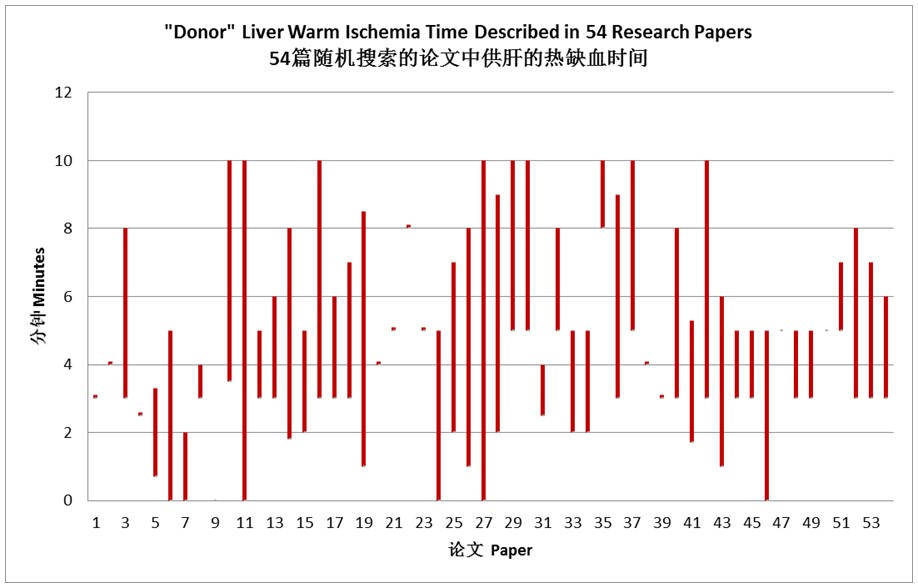
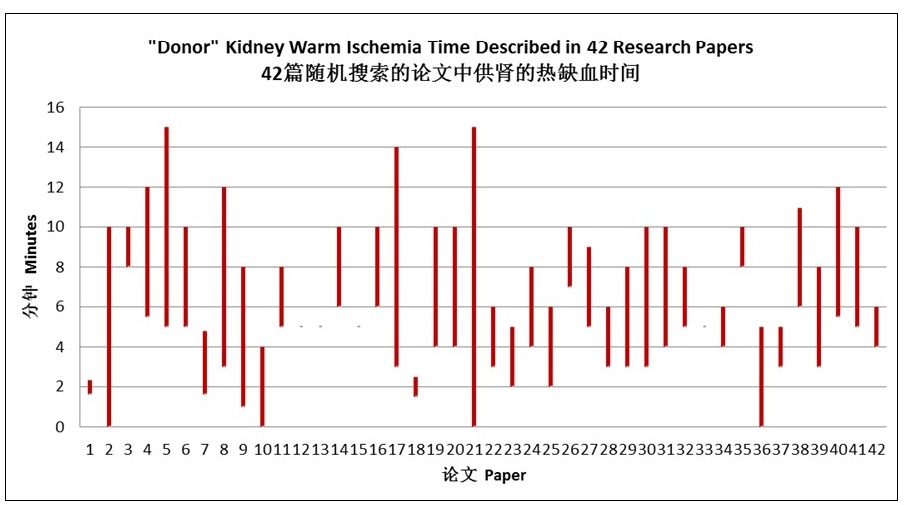
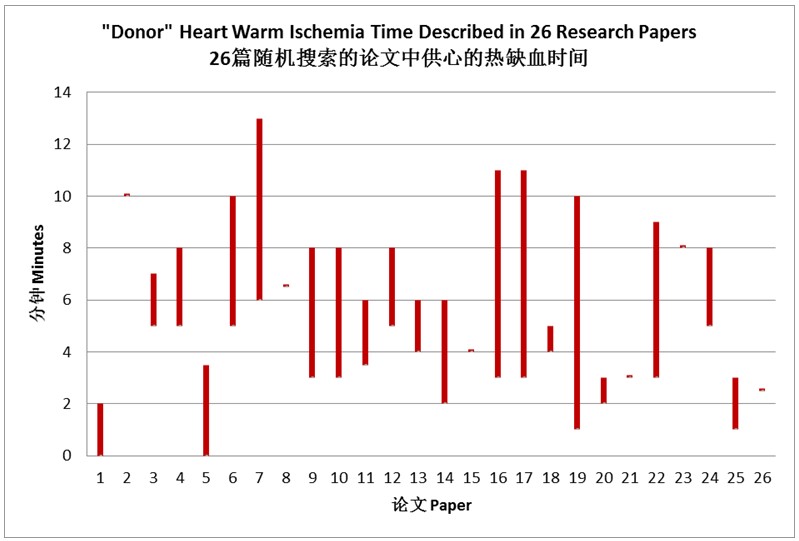
The living donor cases were excluded from the above data. Most warm ischemia time was 4 to 6 minutes. Such fast organ removal can only be possible when the time and location of “donor” death are predictable. The time and location of death of executed prisoners are indeed predictable, but the number of executed prisoners is limited and their organs are not all transplantable. There must be another group of “donors,” whose time and location of death is predictable, who out-number the executed prisoners, and whose organs are of high quality.
Below are a few examples of zero or extremely short warm ischemia time.
4.2 First Affiliated Hospital Wenzhou Medical College: Zero Warm Ischemia Time in Heart Removal
A paper by the First Affiliated Hospital of Wenzhou Medical College in Zhejiang province, a.k.a. the First Provincial Wenzhou Hospital of Zhejiang, described 3 heart transplants performed between Feb. 2003 and Apr. 2004. The paper said, “All donors were male, ages 18, 32 and 45; warm ischemia time was zero[53].”
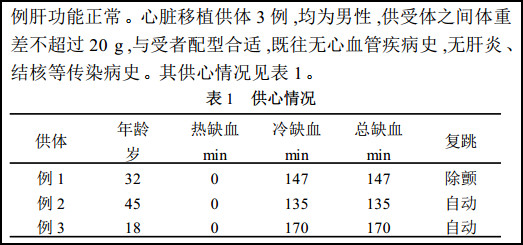
At the time of heart extraction, the heart was still beating. Step 2.1.1 in the graph below said, “Cold cardioplegia was delivered to the heart through the aortic root, in order to make the heart stop beating…”
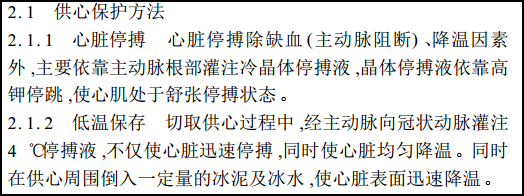
The warm ischemia time of executed prisoner organs cannot be zero. The paper did not use the common excuse of “brain death” either. Is it admitting that the 3 male “donors” were alive?
4.3 Wuxi No.2 People’s Hospital: Zero Warm Ischemia Time in Liver Transplant
A research paper described 5 liver transplants performed by Wuxi No.2 People’s Hospital in Jiangsu Province on Dec. 25, 2000, Jan. 30, 2002, March 13, 2002, Sept. 28, 2002 and March 24, 2003. The paper said, “5 livers were from fresh cadavers whose hearts just stopped beating[54].”

“The livers were of good quality, from brain-dead healthy young men”, “The warm ischemia time of the five livers was almost zero.”
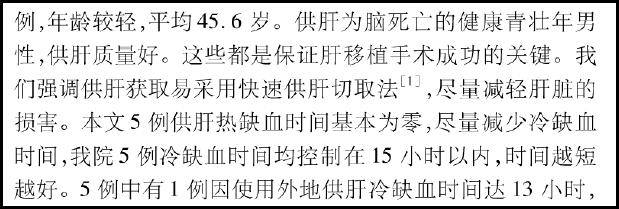
How to extract livers from “brain-dead” healthy young men quickly so that the warm ischemia time would be zero minute? The only explanation is that the healthy young men were alive when their livers were extracted.
4.4 Nanfang Hospital: Zero Warm Ischemia Time in Heart Removal
On April 5, 2000, Guangzhou Southern Medical University (former No.1 Military Medical University) affiliated Nanfang Hospital performed a heart transplant. “The donor was a brain-dead male, had same blood type as the recipient, PRA < 1%, HLA half match, warm ischemia time was 0, cold ischemia time was 90 minutes[55].”
4.5 More Examples of Short Warm Ischemia Time
Table 2. Examples of Extremely Short Warm Ischemia Time
|
Hospital Name |
Time Period of Transplants |
Warm ischemia Time of Extracted Organs |
|
|
1 |
南京医科大学附属医院 The Affiliated Hospital of Nanjing Medical University |
2005/3 - 2007/11 |
125例肝移植中有112例为“尸体供体”,但是这些供肝的热缺血时间却在0到10分钟之内,平均为3.96分钟[56]。 Among 125 liver transplants, 112 were from deceased “donors.” The warm ischemia time was 0-10 minutes, average 3.96 minutes. |
|
2 |
浙江大学医学院附属第二医院 The Second Affiliated Hospital of Zhejiang University School of Medicine |
1999/8/31 – 2001/2/9 |
实施肝移植10例,供体10例脑死亡者,采取多器官联合快速切取,热缺血时间0~5min,平均3.06min[57]。 Conducted 10 liver transplants, all 10 “donors” were brain dead. Fast simultaneous extraction of multiple organs was conducted. The warm ischemia time was 0-5 minutes, averaging 3.06 minutes. |
|
3 |
江苏南通医学院附属医院 The Affiliated Hospital of Nantong Medical College, Jiangsu Province |
2000/11 – 2003/5 |
4例原位心移植的供体为“脑死亡者,男3名,女1名,死前心功能正常。4例供体在脑死亡后快速正中开胸。。。。”此4例供心的热缺血时间为0到2分钟[58]。 4 orthotopic heart transplant “donors” were brain-dead, 3 were male, 1 was female, heart function normal before death. All 4 “donors” chest were cut open quickly after brain death…” The warm ischemia time was 0 to 2 minutes. |
|
4 |
南京市鼓楼医院 Nanjing Drum Tower Hospital, Jiangsu Province |
2004/6 – 2005/6 |
获得42例供肝,热缺血0-5min,供体为“脑死亡,19-38岁,无传染性、感染性疾病及肝肾疾病”[59]。 Obtained 42 donor livers, with warm ischemia time of 0 to 5 minutes. “Donors” were brain dead, 19 to 38 years of age, free of infectious diseases, kidney and liver diseases. |
|
5 |
解放军第二炮兵总医院 The Second Artillery General Hospital of Chinese People’s Liberation Army, Beijing |
2004/7 – 2007 |
实施的103例肝移植,“供体都是健康的年轻人,其中脑死亡供肝1例,其余为同血型尸体供肝。”然而这103例供肝的热缺血时间却为0到5分钟[60]。如果这些供体在被切取肝脏的时候已经是尸体的话,热缺血时间是如何控制在5分钟以内的? 103 liver transplants, “all donors were healthy young people, 1 brain-dead donor liver, 102 deceased donor liver. Donors and recipients have the same blood type. All 103 cases have warm ischemia time of 0 to 5 minutes. (If these “donors” were already dead at the time liver extraction, how could warm ischemia time be possibly controlled within 5 minutes?) |
|
6 |
上海第二军医大学长征医院 Shanghai Changzheng Hospital |
2001/10 – 2004/9 |
实施的240例肝移植,所使用的供肝热缺血时间为0-8min[61]。 All 240 liver transplants had warm ischemia time of 0 to 8 minutes. |
|
7 |
东莞市人民医院 Dongguan People’s Hospital, Guangdong Province |
2003/4 – 2003/12 |
先后为4例患者施行原位心脏移植,供心热缺血时间(0~3.5min)[62]。 4 orthotopic heart transplants with warm ischemia time of 0 to 3.5 minutes. |
|
8 |
福建医科大学附属协和医院 Fujian Medical University Affiliated Xiehe Hospital |
1995/8 – 2009/3 |
96例同种异体心脏移植,供体均为男性脑死亡者,20-45岁,热缺血时间0-15min,冷缺血时间50-235min[63]。 96 orthotopic heart transplants, “donors” were brain-dead male, ages 20 to 45, warm ischemia time was 0 to 15 minutes, cold ischemia time was 50 to 235 minutes. |
|
9 |
天津第一中心医院 Tianjin No.1 Central Hospital |
2003/9 – 2005/11 |
200例供肝切取情况,供体为:本组200例脑死亡的供体中男性191例,女性9例,均为无心跳尸体供肝[64]。在200例供肝中有190例的热缺血时间小于8分钟,进一步证明摘取肝脏的过程就是“供体”从活体到“无心跳尸体”的过程,而且整个过程是有预谋的。 200 brain-dead “donors” liver removal, 191 males and 9 females; all were extracted from non-heart-beating cadavers. 190 cases had warm ischemia time less than 8 minutes. (Suspiciously short warm ischemia time of non-heart-beating cadaver livers suggests the process of liver removal could be the process of turning living donors to non-heart-beating donors. Such process could be premeditated.) |
5 “Donors” were Mostly Young Healthy Male
Among the over 300 research papers, 103 papers have information about the “donors,” such as sex, age, cause of death, blood type, and various test results, etc. An analysis of the “donor” information results in some common characters about the “donors.”
5.1 Absolute Majority of “Donors” were Male
The total number of “donors” mentioned in the 103 research papers is 8710. Among which 3444 “donors” have no sex information. In the rest 5266 “donors,” 97% were male, as shown in the figure below.
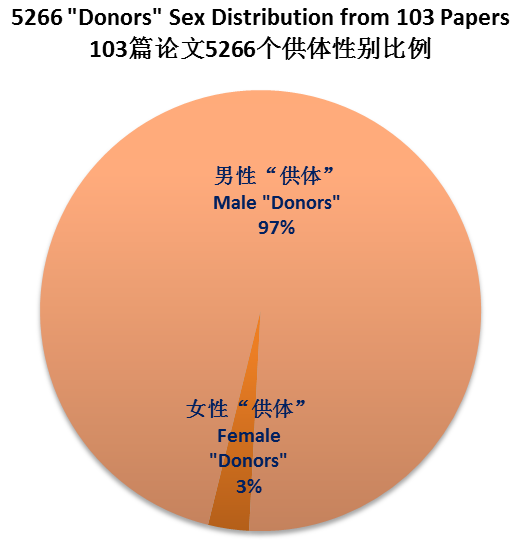
5.2 Absolute Majority of “Donors” were under 40 Years of Age
There are 80 papers that include the age range of the “donors”, as shown in the figure below. The Y-axis is the age. The figure shows that most “donors” were 20 to 40 years old.
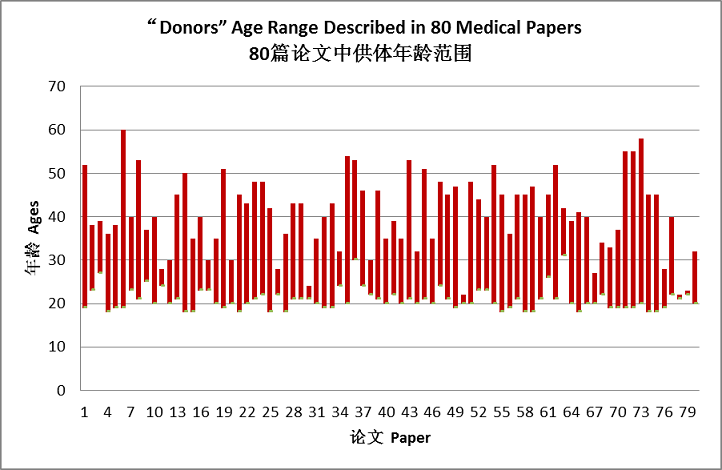
5.3 “Donors” in perfect health, unlike regular prison population
Among all the transplant performed from Aug. 2005 to Jan. 2006 by Shandong province Zaozhuang Central District People’s Hospital and Hebei United University Affiliated Hospital, 3 combined kidney-pancreas transplants were described in a medical paper. The only sentence that described the “donors” was: “donors had no history of alcohol use, no history of medication, no diabetes, no pancreatitis, and no pancreatolithiasis[65].”

The paper did not specify the sex, age, blood type and other test results of the “donors.” It is very unlikely the “donors” here were executed prisoners. How many executed prisoners could a mid-sized city like Zaozhuang have every year? How many of them “have no history of alcohol use and no medication”? How many have perfect tissue match with the recipients? And how could Zaozhuang Central District People’s Hospital and Hebei United University Affiliated Hospital manage to find 3 perfect “donors” in 6 months?
In the 103 liver transplants performed by the Second Artillery General Hospital of Chinese People’s Liberation Army in Beijing between July 2004 and 2007, the “donors” were “all healthy young persons. One liver was from a brain-dead donor and standard extraction was performed, the rest were from cadavers and used fast extraction. The cadavers and the recipients have the same blood types. The warm ischemia time was 0-5 minutes[66].” In fewer than 3 years, where did the 103 healthy young persons with identical blood type as the recipients come from? How could all 102 cadaveric livers have warm ischemia time of less than 5 minutes?
The table below gives more examples of “donors” with perfect health.
Table 3. Examples of “Donors” with Perfect Health
|
Hospital Name |
Time Period of Transplants |
Description of “Donors” |
|
|
1 |
东莞市太平人民医院 Dongguan (city) Taiping People’s Hospital |
2002/8 – 2005/8 |
实施350例肾移植。其中肝脏联合切取组90例,单独切取肾脏260例,供体年龄20~30岁,肝功化验检查正常,HBsAg、HBeAg、HBeAb、HCV-Ab、HEV-Ab、HIV-Ab、RPR、TPPA等指标均为阴性[67]。 90 combined liver-kidney extractions and 260 liver extractions. “Donors” were 20 to 30 years of age, liver function tests normal, HBsAg、HBeAg、HBeAb、HCV-Ab、HEV-Ab、HIV-Ab、RPR、TPPA tested negative. |
|
2 |
北京军区总医院 Beijing Military Region General Hospital |
2005/ 4 – 2007/7 |
实施30例原位肝移植和供体切取,为尸体供肝,行肝肾联合切取,供肝者年龄18~42岁。无乙肝、梅毒、艾滋病、结核、恶肿瘤及慢性病,供肝热缺血时间为2~7min,平均为4.6min[68]。 30 liver transplants, combined liver-kidney extraction from cadavers. “Donors” were 18 to 42 years of age, Hepatitis B, Syphilis, HIV tested negative, no Tuberculosis, no malignant tumor, no chronic illnesses. |
|
3 |
海军总医院 Navy General Hospital |
2005/3- 2005/8 |
实施3例原位心脏移植,供体为脑死亡者,年龄31岁、22岁和28岁,无心血管疾病或其他重大脏器疾病史[69]。 3 heart transplants, “donors” were brain-dead, ages 31, 22 and 28, no history of cardiovascular diseases and any other key organ diseases. |
|
4 |
首都医科大学附属北京安贞医院 Capital Medical University Affiliated Anzhen Hospital |
1992/4 – 2006/4 |
实施51例原位心脏移植,供体51例,均为男性,年龄21~43岁,既往无心血管疾病或其他重大脏器病史,摘取供心的路途时间在1h内[70]。 51 heart transplants, all male, ages 21 to 43, no history of cardiovascular diseases and any other key organ diseases. Transportation took less than 1 hour. (In all 51 cases, the distance between where hearts were extracted and where transplantations were conducted was less than 1 hour.) |
|
5 |
山东省千佛山医院 Qianfoshan Hospital, Shandong province |
2002/1 – 2005/1 |
肝脏移植中心实施43例44次肝移植,无乙肝、丙肝、艾滋病、梅毒等经血传播性疾病,整块切取,热缺血时间5~10min,平均5.6min[71]。 44 liver transplants, “donors” had no Hepatitis B, Hepatitis C, HIV, Syphilis and other blood transmitted diseases. The warm ischemia time was 5 to 10 minutes, averaging 5.6 minutes. |
|
2003/3 - 2012/10 |
心外科实施25例同种异体原位心脏移植和供体切取。供体年龄20~35岁,无心血管疾病史[72]。 25 heart extractions and transplants, “donors” were 20 to 35 years of age, with no history of cardiovascular diseases. |
||
|
6 |
山东省立医院 Shandong Provincial Hospital |
2005/1-2008/12 |
6例肝肾联合移植,供体年龄19~40岁,平均28岁,无酗酒史,无恶性肿瘤、感染、糖尿病等疾病,肝、肾功能正常,肝炎、HIV等标志物阴性。热缺血时间为2.5~4min[73]。 6 combined liver-kidney transplants, “donors” were 19 to 40 years of age, averaging 28. No history of alcoholic use, no malignant tumors, no infectious diseases, no diabetes, liver and kidney function normal, HIV tested negative. Warm ischemia time was 2.5 to 4 minutes. |
|
7 |
潍坊市人民医院 Weifang People’s Hospital |
2001/3 – 2006/8 |
9例原位全肝移植,均取自健康青年新鲜尸体,供体均肝功能正常,乙肝五项阴性。采用快速整块切取法,热缺血时间约为5~8min[74]。 9 liver transplants, cadaveric livers from healthy young people, liver function normal, five tests of Hepatitis B negative, fast extraction method was used, warm ischemia time was 2.5 to 4 minutes. |
|
8 |
山东省滨州医学院附属医院 Affiliated Hospital of Binzhou Medical College, Shandong Province |
2004/10 /22 |
1例右侧单肺移植手术和供体切取,供体男性,无心肺病史,无吸烟史,供肺热缺血时间为2min[75]。 One lung transplant, “donor” was male, no history of cardiovascular and lung diseases, no history of smoking, warm ischemia time was 2 minutes. |
|
9 |
济南市第四人民医院和福建医科大学附属协和医院 Jinan No.4 People’s Hospital & Fujian Medical University Affiliated Xiehe Hospital |
2006/7/1, 2006/8/6 |
合作完成2例心脏移植和供体切取,供体为38岁和26岁,平素身体健康[76]。 2 heart extractions and transplants, “donors” were 38 and 26, and had always been in good health. |
|
10 |
山东济宁医学院附属医院 Jining Medical College Affiliated Hospital, Shandong Province |
2002/12/13 |
1例肝移植和供体切取,供肝者为青年男性,脑外伤死亡,生前体健、肝功能正常,供肝热缺血时间为4min[77]。 One liver extraction and transplantation, “donor” was male, died of traumatic brain injury, in good health when alive, liver function normal, warm ischemia time was 4 minutes. |
|
11 |
济南市中心医院 Jinan Central Hospital |
2002/8 |
1例肝移植和供体切取,供者25岁,无感染、恶性肿瘤、慢性肝病[78]。 One liver extraction and transplantation, “donor” was 25 years of age, no infections diseases, no malignant tumors, and no liver diseases. |
|
12 |
复旦大学附属中山医院 Fudan University Affiliated Zhongshan Hospital |
2000/5 – 2011/4 |
298例原位心脏移植,尸体供心291例,临床脑死亡7例,年龄18~45岁,平均(26.8±4.5)岁,其中男性283例,女性15例。均无明确心血管疾病或其他重大脏器疾病史,这298例中,自2007年后有60例供心在心室颤动或心搏停止状态下获取,其余在心脏仍搏动时获取[79]。 298 heart transplants, 291 cadaveric hearts, 7 cases of brain-dead donor hearts, ages 18 to 45, average age 26.8±4.5, 283 male and 15 female. All “donors” had no obvious history of cardiovascular diseases and other major organ diseases. Since 2007, 60 hearts were extracted after the hearts stopped beating, and the rest were extracted while the hearts were beating. |
|
13 |
南京军区福州总医院 Nanjing Military Region Fuzhou General Hospital |
1999-2004 |
实施肝肾联合快速切取法切取供肝及肾40例次,并施行同种异体肝移植40例,本组40例供体均为男性无心跳尸体,平均年龄27岁(21~45岁)。术前肝功能均正常、HIV抗体阴性[80]。 40 fast kidney-liver extractions and liver transplants, all 40 “donors” were male non-heart-beating cadavers, average age 27 (21 to 45 years of age). Liver function normal and HIV negative. |
|
14 |
哈尔滨医科大学附属第二医院 No.2 Affiliated Hospital, Haerbin Medical University |
2004/1 |
实施心脏移植1例,供心取自脑死亡者,37岁,体重72kg。死亡前身体健康,热缺血时间小于5min[81]。 One heart transplant, “donor” was 37 years old and brain-dead, weighed 72kg, was in good health when alive, warm ischemia time was less than 5 minutes. |
|
15 |
安徽无锡市人民医院 Wuxi People’s Hospital, Anhui Province |
2002/9-2011/1 |
实施100例供肺获取和101例肺移植,供体无原发性心脏病史和肺脏病史。无心肺手术史。无严重胸外伤、无广泛性肺挫伤、无吸入性肺炎/化脓症,无恶性病变、HIV和肝炎病毒筛选阴性[82]。 100 lung extractions and 101 lung transplants, “donors” had no history of primary heart disease, no history of lung diseases, no history of heart or lung surgery, no severe chest injury, no lung injury, no Aspiration pneumonia, no Suppurative disease, no malignant lesions, HIV and Hepatitis tested negative. |
|
16 |
南京医科大学第一附属医院 No.1 Affiliated Hospital, Nanjing Medical University |
2004/10-2006/4 |
实施原位肝脏移植的117例和尸体供肝,供肝均无肝脏基础疾病、恶性肿瘤及明显脂肪变性,乙型肝炎血清学检查阴性。采用腹主动脉和门静脉快速双灌注法获取供肝[83]。 117 liver transplants using cadaveric livers, “donors” had no liver diseases, no malignant tumors, no obvious Steatosis, Hepatitis B Serology tested negative. |
|
17 |
苏州大学附属第一医院 No.1 Affiliated Hospital of Suzhou University |
2000/8-2001/4 |
实施5例原位肝移植和供体切取,供体年龄20~40岁,无感染、恶性肿瘤及慢性肝病[84]。 5 liver transplants and extractions, “donors” were 20 to 40 years of age, no infectious diseases, no malignant tumors, no chronic liver diseases. |
|
2000-2006年 |
实施心脏移植6例和供体切取,供者年龄25~37岁,无心血管病史,淋巴细胞毒抗体试验阴性,供受者血源的巨细胞病毒、EB病毒、肝炎病毒和艾滋病病毒均为阴性[85]。 6 heart extractions and transplants, “donors” were 25 to 37 years of age, no history of cardiovascular disease, lymphocyte cross matching negative, Cytomegalovirus, EB virus, Hepatitis virus, and HIV tested negative. |
||
|
18 |
南京鼓楼医院 Nanjing Drum Tower Hospital |
2004/6-2005/6 |
实施42例尸体肝肾联合切取,共获得42个供肝、84个供肾,供体男40例,女2例,年龄19~38岁,无传染性、感染性疾病及肝肾疾病[86] 42 combined kidney-liver extractions, “donors” were 19 to 38 years of age, 40 were male, 2 were female, no infectious diseases, no kidney or liver diseases. |
|
19 |
镇江市第一人民医院 Zhenjiang No.1 People’s Hospital |
2005/4 - 2006/12 |
实施4例全心脏原位移植和供体切取,供体均为男性,年龄23~40岁,既往无心、肺疾病史及胸部手术史[87]。 4 heart extractions and transplants, “donors” were male, ages 23 to 40, no history of cardiovascular and lung diseases, and no history of thoracic (chest) surgery. |
|
20 |
南京市第二医院 Nanjing No.2 Hospital |
2004/3-2004/11 |
实施快速联合切取11个供肝、22个供肾移植给相应受体。11例供体均为脑死亡,年龄18~36岁,无传染性、感染性疾病,无肝肾及其它严重疾病[88]。 11 fast combined liver-kidney extractions, all “donors” were brain-dead, ages 18 to 36, no infectious diseases, no lung diseases, no liver diseases, no other serious illnesses. |
|
21 |
无锡市第二人民医院 Wuxi No.2 People’s Hospital |
2000/12-2003/3 |
实施原位肝移植5例和供体切取,采用快速供肝切取技术,供肝为脑死亡的健康青壮年男性[89]。 5 liver extractions and transplants, “donors” were brain-dead, healthy, young adult male. |
|
22 |
徐州医学院附属医院 Xuzhou Medical College Affiliated Hospital |
2002/4-2002/7 |
实施了2例同种异体原位心脏移植手术,2例供者均为男性,28岁和24岁,脑外伤死亡。供者生前体健,血清乙肝、巨细胞、EB病毒检查均为阴性[90]。 2 heart transplants, “donors” were male, ages 28 and 24, died of traumatic brain injury. “donors” had been in good health, Hepatitis B, Cytomegalovirus, EB virus (血清乙肝、巨细胞、EB病毒检查) tested negative. |
|
23 |
河北医科大学第二医院 Hebei Medical University No.2 Hospital |
2001/10-2002/10 |
施行肝移植5例。均为尸体供肝,供者年龄20~40岁,无感染、恶性肿瘤及慢性疾病,采用单独灌洗切取法[91]。 5 liver transplants, all cadaveric livers, “donors” ages 20 to 40, no infectious diseases, no malignant tumor, no chronic diseases. |
|
24 |
中南大学附属湘雅二医院 Second Xiangya Hospital of Central South University |
Until 2006年 |
参与实施60例尸体肝肾联合切取,其中30例为无心跳尸体供体,男28例,女2例,年龄19~37岁,术前检查免疫缺陷病毒和肝炎病毒系列均为阴性,肝肾功能正常[92]。 60 combined liver-kidney extractions from cadavers, 30 cases were non-heart-beating cadaver “donors,” 28 males, 2 females, preoperative testings for immune system diseases and Hepatitis were negative, kidney and liver function normal. |
|
25 |
中南大学湘雅三医院 Third Xiangya Hospital of Central South University |
2002/3-2005/12 |
实施107例肝移植,和供肝切取,均采用原位低温灌注整体器官切除法取肝,供体107例,身体健康[93]。 107 liver extractions and transplants, low temperature perfusion to the organs during extraction, all “donors” were healthy. |
|
2004/1-2008/6 |
实施91例原位肝移植和供体切取,男80例,女11例,年龄19~55岁,平均29岁,术前肝肾功能及病毒学检查均正常。采用多器官联合快速切取[94]。 91 liver extractions and transplants, “donors” were 19 to 55 years of age, averaging 29. 80 males, 11 females, preoperative testing of liver and kidney functions normal, virological examination also normal. Multi-organ fast extraction method was used. |
||
|
2004/1-2006/7 |
实施64例供肝切取,供体为无心跳尸体,年龄19~55岁(平均32.5)。术前检查肝肾功能正常,无脂肪肝,丙型肝炎抗体、人类免疫缺陷病毒(HIV)抗体无1例阳性[95]。 64 liver extractions from non-heart-beating cadavers, “donors” ages 19 to 55 (average 32.5). Preoperative liver and kidney function testing normal, no fatty livers, Hepatitis C and HIV all tested negative. |
||
|
26 |
中国医科大学附属第一医院 China Medical University Affiliated No.1 Hospital |
1995/5-2005/6 |
实施了122例原位肝移植,采用腹腔器官联合快速切取技术进行了165例供肝和供肾联合切取,供肝切取全部为脑死亡者,年龄20~54岁,男119例,女3例。术前检查艾滋病病毒和肝炎病毒系列均为阴性,肝、肾功能均正常[96]。 122 orthotopic liver transplants, 165 combined liver-kidney extractions, “donors” were all brain-dead, ages 20 to 54, 119 males, 3 females, preoperative HIV and Hepatitis testing negative, liver and kidney function normal. |
|
27 |
第四军医大学附属西京医院 |
2001/1/26-2003/9/26 |
实施26例原位心脏移植和供体切取,供体为男性,脑死亡,无心血管病史[97]。 26 orthotopic heart transplants and extractions, “donors” were male, brain-dead, no history of cardiovascular diseases. |
|
28 |
解放军第452医院 |
20067-2009/10 |
实施尸肾移植164例和供体切取,供者男性81例,女性1例,年龄22~46岁,平均年龄32.3岁。供者传染病检查无结核、肝炎、梅毒、艾滋病等传染性疾病[98]。 164 kidney transplants and extractions, “donors” were 81 males, 1 female, ages 22 to 46, average 32.3, no Tuberculosis, no Hepatitis, no Syphilis, no HIV and other infectious diseases. |
|
29 |
四川省人民医院 |
2007/8-2009/4 |
完成肾移植34例和供体切取,供者平素身体健康,无高血压、心脏病、肺结核、糖尿病、肝肾疾病等病史[99]。 34 kidney transplants and extractions, “donors” were healthy, no high blood pressure, no cardiovascular disease, no Tuberculosis, no diabetes, no kidney and liver diseases. |
|
30 |
浙江温州医科大学附属第一医院 |
2001/3-2004/12 |
对35例肝炎后肝硬化和急性重症肝炎患者施行肝移植,其中标准原位肝移植组11例,经典背驮式组9例,改良背驮式组15例,和供肝切取,采用肝肾联合快速获取技术。所有供体来自脑死亡健康成人,供肝热缺血时间3~7min,平均4.4min[100]。 35 orthotopic liver transplants and extractions, all “donors” were brain-dead healthy adult, warm ischemia time was 3 to 7 minutes, average 4.4 minutes. |
|
2003/2-2004/1 |
进行了2例原位心脏移植,尸体供心,年龄小于35岁,既往无心血管疾病史,无肝炎结核等传染病史[101]。 2 orthotopic heart transplants from cadaveric “donors,” all younger than 35 years of age, no history of cardiovascular diseases, no Hepatitis, no Tuberculosis, and other infectious diseases. |
||
|
31 |
武警山西总队医院,武警总医院 Shanxi Armed Police Corps Hospital, Armed Police Forces General Hospital |
2004/10-2006 |
共同完成的肝移植手术12例和供体切取,供肝均取健康男性严重颅脑外伤死亡者[102]。 12 liver transplants and extractions, all liver “donors” were male, died of traumatic brain injury. |
|
32 |
内蒙古医科大学附属医院 Inner Mongolia Medical University Affiliated Hospital |
2003/8-2004/12 |
完成2例原位心脏移植,供体均为男性,31岁和42岁,脑死亡供心,生前体健[103]。 2 orthotopic heart transplants, “donors” were male, 31 and 42 years of age, brain-dead, in good health. |
|
33 |
东莞市人民医院 Dongguan People’s Hospital |
2003/4-2003/12 |
先后为4例患者施行原位心脏移植,供体均为男性,脑死亡者,年龄20~30岁。既往没有心血管疾病史,供心热缺血时间(0~3.5min)[104]。 4 orthotopic heart transplants, “donors” were male, brain-dead, ages 20 to 30, no history of cardiovascular diseases, warm ischemia time 0 to 3.5 minutes. |
|
34 |
佛山市第一人民医院 Foshan No.1 People’s Hospital |
1999/12-2001/12 |
实施13例次原位肝脏移植(包括1例再次肝移植)和供体切取,供体年龄20~35岁,无感染、恶性肿瘤及慢性肝病[105]。 13 orthotopic liver transplants (including 1 secondary liver transplant) and extractions, “donors” ages 20 to 35, no infectious diseases, no malignant tumors, no chronic diseases. |
|
35 |
广州军区广州总医院 Guangzhou Military Region Guangzhou General Hospital |
2007 |
实施50例次供体肝肾联合灌注、切取,供者丙肝抗体、乙肝两对半、梅毒抗体、HIV抗体等传染性疾病指标均为阴性,无肝、肾器质性疾病[106]。 50 combined liver-kidney extractions and transplants, “donors” had no Hepatitis C, no syphilis, no HIV, no liver and kidney diseases. |
|
36 |
解放军第107医院 107 Hospital of PLA |
2003/1-2010/10 |
完成168例肝脏移植,所有为尸体供肝。供肝无恶性肿瘤,艾滋病抗体、梅毒抗体、丙肝抗体均为阴性,2例表面抗原阳性,余均为阴性[107]。 168 liver transplants, cadaveric livers, no malignant tumors, HIV, syphilis, Hepatitis C tested negative. 2 cases of surface antigen positive, rest were negative. |
The above examples are taken from papers published between 2000 and 2012. The number of “donor” organs involved in each case various from a few to over a hundred. One thing in common is that these “donors” were healthy individuals, not older than 40 years old. These healthy young people were not voluntary donors. They cannot be categorized as prisoned criminals either, because this group of “healthy young people” differentiate themselves from prison population in their health conditions.
Below are results of health screenings performed on prison populations.
From Jan. 2005 to May 2009, a health screening was done among the population in drug rehab centers and prisons in Qingyuan city, Guangdong province. The tests included HIV, Syphilis, Hepatitis B and Hepatitis C[108]. The result is shown in the table below. The 4,973 prisoners were all male, ages 19 to 70, average age 29.23, 85% were ages 20 to 39[109].
|
Type of people tested |
Number of people tested |
Percentage of HIV(+) |
Percentage of Syphilis (+) |
Percentage of HCV(+) |
Percentage of HBsAg(+) |
|
Drug addicts |
1073 |
3.08% |
9.97% |
45.01% |
22.93% |
|
Prisoners |
4973 |
0.30% |
0.62% |
9.63% |
2.03% |
The Hepatitis B test was done on 482 prisoners in Xinjiang province Guitun Prison between 2008 and 2012. 9.2 percent tested positive[110].
The Hepatitis B test was done on 652 males, ages 20 to 68, in prisons and labor camps in Mudanjiang city, Heilongjiang province. 16.72% were tested positive[111].
Tests (HIV, Syphilis, Hepatitis B and Hepatitis C) were done on 3 types of people, namely blood donors, peasants, and prisoners in Heze city, Shandong province in 2006. The result is shown in the table below.

|
Number |
HIV |
TP |
HBsAg |
HCV |
|||||
|
Number of positive cases |
Percentage of positive cases (%) |
Number of positive cases |
Percentage of positive cases |
Number of positive cases |
Percentage of positive cases |
Number of positive cases |
Percentage of positive cases |
||
|
Blood donors |
2218 |
1 |
0.05 |
5 |
0.22 |
7 |
0.32 |
2 |
0.09 |
|
Peasants |
222 |
0 |
0 |
2 |
0.90 |
8 |
3.60 |
2 |
0.90 |
|
Prisoners |
1543 |
1 |
0.06 |
19 |
1.23 |
122 |
7.91 |
21 |
1.63 |
|
Total |
3983 |
2 |
0.05 |
26 |
0.65 |
137 |
3.44 |
25 |
0.63 |
The positive cases among prisoners are more than the non-prisoners[112].
A Hepatitis B test was conducted on 482 prisoners in Hangzhou city, Zhejiang province in 2009 and 29% were tested positive[113].
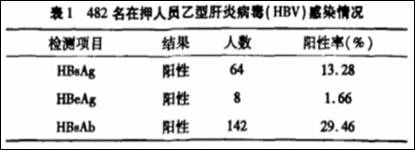
The “donors” in China were not the conventional prisoners. Based on their health condition, it is very likely that the majority of “donors” were captive Falun Gong practitioners.
6 Tissue Typing Labs Established after 2000
In China, many tissue typing labs were established after 2000.
6.1 Examples of Tissue Typing Labs Established after 2000
In 2002, Hebei province Organ Transplant Tissue Typing Center was established at the Hebei Provincial Blood Bank. Its main task is to perform HLA testing for kidney patients. The Center claims to have finished over 100,000 HLA testing for Chinese Bone Marrow Donor Library and served over 4,000 patients for tissue matching, domestic and abroad, by 2012[114].
Liaoning province Dalian Organ Transplant Tissue Typing Center was setup in 2001 by the Dalian city Bureau of Health. The main services are testing for kidney and liver transplants and stem cells[115].
In 2007, Jiangxi province Blood Center became a qualified HLA test lab for China Bone Marrow Bank[116].
Guangdong province Shenzhen Blood Center started HLA testing on Aug. 1, 2000. As of 2013, it claims to have performed over 50,000 HLA testing and 3,200 HLA high-resolution genotyping between non-blood-related donor and recipients[117].
Bejing Red Cross Blood Center HLA Lab started in 2001. By 2010 it has collected over 110,000 donor DNA and performed over 100,000 HLA genotyping[118].
This is another proof that after 2000 there was a boost in “donor” organs, which generated more demand in tissue typing for organ transplant. Many labs started HLA testing for profit.
6.2 Forensic Pathology Key Laboratory: Operated by Ministry of Health, Ministry of Public Security and the Supreme People’s Court
The Ministry of Health Forensic Pathology Key Laboratory was established in Oct. 1999 at Xi’an Jiaotong University. The Laboratory was co-founded by the Ministry of Health, Ministry of Public Security and the Supreme People’s Court. It claims that “the research in organ transplant tissue matching has reached advanced international level[119].”
Three months after the persecution of Falun Gong started, the Chinese Communist Party controlled Ministry of Health, Ministry of Public Security and Supreme People’s Court jointly established the “Forensic Pathology Key Laboratory” at Xian Jiaotong University in Shaanxi Province. The Key Laboratory was supposed to provide material evidence for criminal cases, instead, it has been involved in organ transplant and tissue matching, which should be an exclusive function of the Ministry of Health. The Ministry of Public Security and its public security system, on the other hand, have full control over the kidnapped and detained Falun Gong practitioners. The Supreme People’s Court and its court system can either “legally” issue death sentences or provide fabricated death sentence certificates for illegal organs. Thus, the Ministry of Public Security and the Supreme People’s Court became the direct beneficiaries of organ transplantation. This relationship provided motivation and practicality for the judicial system to take part in the live organ harvesting of Falun Gong practitioners.
Until December 2012, Xian Jiaotong University Affiliated No.1 Hospital has conducted 3,596 kidney transplants; in addition to directing 23 other hospitals from 13 provinces in the implementation of over 10,000 kidney transplants, as well as “propelled the development of liver, heart, lung, small intestine transplantation[120].”
Until June 2013, Xian Jiaotong University Affiliated No.1 Hospital claims to have finished 69 Donations after Cardiac Death (DCD) heart transplant, 132 DCD kidney transplants, 60 DCD liver transplants. It claimed to have implemented the most DCD transplants and has the most efficiency in utilizing the organs in the country[121]. Until December 2013, Xian Jiaotong University Affiliated No.1 Hospital has conducted 3,764 kidney transplant[122], among which only 132 cases (3.5%) were specified as DCD. The rest 3,632 casaes of kidney transplant have no explanation of the organ source.
7 China’s Transplantation Abnormalities Indicate the Presence of Living Donor Organ Banks
7.1Henan Armed Police Corps Hospital: Transplants after Live Organ Harvesting
The medical journal Henan Medical Research Vol. 12, No 2, 2003 published a research paper titled The Experience of Homologuous Orthotopic Heart Transplantation[123].
There are two descriptions regarding the “donor” heart:
“2.1 Main points in donor heart removal: systemic heparinization (2mg/kg), cold cardioplegia was delivered to the heart through the aortic root until the heart stopped beating, cut superior vena cava at 4cm above right atrium…, quickly transport the heart to the operation room.”
“2.4 Main points in myocardial protection: Maintain stable hemodynamic, after cutting the aortic, deliver cardioplegia to the heart through the aortic root, in the meantime, decrease pressure in right atrium and left atrium in order to ensure perfusion after the heart stopped beating. … The warm ischemia time was 3 minutes; the cold ischemia time was 85minutes.”
From both descriptions, the following conclusion can be drawn: the heart beat was stopped by directly perfusing cardioplegic chemicals after the chest was opened. This is also confirmed by the fact that the donor heart’s warm ischemia time was only three minutes. The cold ischemia time was only 85 minutes, indicating that the heart extraction and transplant took place in the same location.
The transplant was performed in 2001, when there was no definition of brain death and no specification on how to diagnose brain death in Chinese medical field. The earliest “Exposure Draft ” regarding the diagnosis of brain death was published in 2003. It was not until 2010, when the “citizen voluntary donation trial projects” started to adopt the parallel standard of both cardiac death and brain death standards. Moreover, it was done with the acknowledgement that China does not have brain death legislation. In 2013, “over 90% of Chinese doctors do not understand brain death[124].”
Thus, we can conclude that the “brain dead donor” described in this medical research paper was not brain dead. The “cardiac death” was induced arbitrarily by the injection of cardioplegia. The “donor” was murdered due to a heart transplant surgery. This is not the general case when an executed prisoner’s organs were harvested by multiple groups of medical personnel.
7.2 The Second Affiliated Hospital of Harbin Medical University: Dedicated Heart Extraction Team
In a medical research paper, a central operating room nurse at the Second Affiliated Hospital of Harbin Medical University mentioned about the hospital’s “donor” heart extraction team, “The hospital has set up a highly-trained heart extraction medical team, composed of surgeons, anesthesiologists, perfusionists, operating room nurses, blood bank personnel and organ liaisons... After receiving a mandate, the team members quickly convene to conduct preoperative discussions and make work arrangements[125].” In this case, “receiving a mandate” implies that a receptor has been found, and one “donor” will die in the near future.
In the subsequent discussion about “preoperative preparations”, it was mentioned that “to shorten the donor heart’s ischemia time ... a circulating nurse will assist the anesthetist with rapid drug(s) administration”.

This paper does not mention if the “donor” was brain-dead. On the heart extraction site, since the anesthetist “administers drug(s) rapidly”, it indicates that the “donor” was likely a conscious living person.
7.3 Xijing Hospital Shaanxi Province: Living “Donor” in Heart-Lung Transplant
The “donor” in one case of combined heart-lung transplant at Xijing Hospital of Fourth Military Medical University in Xi’an, Shaanxi Province, on May 26, 2008, was likely a living person. A research paper about the operation includes many paragraphs regarding the removal of the “donor” heart and lung[126].
First, this male “donor” was declared “a brain-dead patient”, and then he was intubated. In the intubation active process, the medical staff “quickly cleaned up the secretions from the donor’s nose and mouth, to prevent reflux and being inhaled into the trachea”. Notice that “inhaled into” is used here, indicating that it was the “donor’s” behavior.

The next paragraph mentions that the discharge of residual blood from the heart was accomplished by active heartbeat. Since the residual blood “was emptied within several cardiac cycles”, it indicates that the “donor’s” autonomous heartbeats still existed at that time.
In the end, the paper mentions that the same harvesting method had been used on 38 other “donors.” This means, around 2008, at least 38 living persons’ hearts and lungs were harvested at Xijing Hospital of Fourth Military Medical University in Xi’an. Since China has no brain-death legislation, as long as the heart is still beating, the “donor” should be considered alive. As previously mentioned, without intubation and connected to a ventilator, a person cannot be diagnosed brain-dead.
7.4 PLA No.281 Hospital: Matching Kidney in One Day
People's Liberation Army (PLA) No. 281 Hospital is located in the seaside health resort of Beidaihe District in Qinhuangdao City, Hebei Province. In a medical paper, the hospital was claimed to be a “medium-sized hospital, with small-scale operating rooms and a small number of scarcely equipped staffs…Our hospital’s anesthesiology department has 3 operating rooms and 6 to 8 nurses.” Three different research papers published in 2005, 2008 and 2013 described how the hospital managed to perform hundreds of kidney transplants; in particular, how to simultaneously accomplish 6 to 9 transplant operations, despite of its lack of medical personnel and equipment.
The 2005 paper states that from 1991 to 2004, the hospital completed 245 kidney transplants. There were 18 instances, when 6 to 9 transplant operations were performed simultaneously[127].
The 2008 paper states that from 1991 to 2007, the hospital completed 313 kidney transplants. There were 28 instances, where 6 to 9 transplant operations were performed simultaneously[128].
The 2013 paper states that from 1991 to 2012, the hospital completed 510 kidney transplants[129].
The statistics provided in these research papers only made up part of the total number of transplant operations performed in this hospital. It shows that the total number of kidney transplants has been continuously increasing. It is evident that the hospital has always been in easy access to an ample supply of kidneys, to be able to perform an increasing number of kidney transplants year after year.
Based on the information given by the 3 medical research papers, the annual average number of kidney transplant can be derived, and shown in the table below.
During the 13 years from 1991 to 2004, a total of 245 kidney transplants were performed, at an average of 19 cases per year;
During the 3 years from 2005 to 2007, a total of 68 (313 minus 245) kidney transplants were performed, at an average of 23 cases per year;
During the 5 years from 2008 to 2012, a total of 197 (510 minus 313) kidney transplants were performed, at an average of 39.4 cases per year.
|
Time Frame |
Total Number of Kidney Transplant |
Annual Average |
|
1991 to 2004 |
245 |
19 |
|
2005 to 2007 |
68 |
23 |
|
2008 to 2012 |
197 |
39.4 |
Especially noteworthy is that after 2006, when the Chinese regime’s live organ harvesting was exposed, the number of transplant operations in this hospital continued to increase. Hebei Province, where PLA No. 281 Hospital is located, was not a pilot province for the human organ donation program started in 2010. It was only after 2013, that the organ donation program was promoted across China. The insignificant number of donated organs is not the cause of the increase in number of transplant at No. 281 Hospital.
In addition to an ample supply of kidneys, PLA No.281 Hospital has been able to acquire and match “donor” kidneys at an astonishing speed. On January 28, 2002, the urology department at the PLA No. 281 Hospital (currently Beidaihe Sanatorium of Beijing Military Region) performed 7 cadaveric kidney transplants[130]. In one case, the receptor was admitted into the hospital on November 13, 2001. On January 28, 2002, he underwent the first kidney transplant. And on February 5, 2002, a secondary kidney transplant was done. The process to obtain the second “donor” kidney, as described in the paper, shows that the wait time for the second kidney was one day.
The research paper describes the decision process for the second kidney transplant:
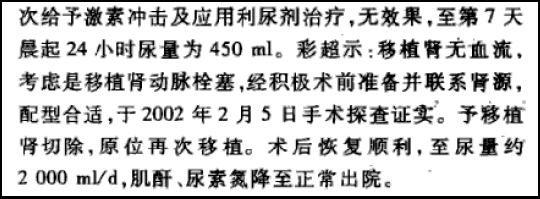
The first transplant date was January 28, 2002. The paper mentions that “on the early morning of the 7th day, the patient’s urine volume during the 24-hour period was…” The “7th day” refers to the 7th day after the first transplant operation, and it was February 4, 2002. On that day, “considering the transplanted kidney’s clogged arteries”, the doctors decided to perform another transplant. So, “with proactive preoperative preparations and contacting the kidney liaison, a suitable match was found. On February 5, 2002, the transplanted kidney was removed, and secondary kidney transplant was performed.”
In this case, the process of “contacting the kidney liaison” and “finding a suitable match” only took one day on February 4. In other countries, this process would probably take two or three years. However, at the PLA No. 281 Hospital, it took only one day. This indicates the existence of a large living “donor” bank most likely controlled by the Chinese military.
The PLA No. 281 Hospital is part of the Beidaihe Sanatorium of Beijing Military Region, which include PLA No.178 Hospital and the Navy Beidaihe Sanatorium[131].
7.5 Xi'an Gaoxin Hospital: “cramping in an old and beaten-down van to extract organs”
Xi'an Gaoxin Hospital was founded in 2002. At its inception, the hospital’s urology department only had “a few patients and empty wards.” At that time, the organ transplant business in China was experiencing an unusual growth. Gaoxin Hospital made the decision to “develop organ transplantation as the main direction,” The hospital started to conduct kidney and liver transplants. “The hospital’s leaders and department heads traveled far and frequently in search for kidneys and patients.” They were able to attract “foreign patients from South Korea, Japan, Israel and other countries.” Five years after the hospital was established, “the annual income (from organ transplantation) exceeded ten million yuan.” It is evident that the huge profit is one of the driving force behind the organ transplant frenzy in mainland China.
On the hospital’s website, an article describes how Gaoxin Hospital harvested organs back then: “Whether it was hot summer or cold winter, 4 or 5 staff members would crouch in an old and beaten-down van to harvest organs,” and “sometimes, 7 to 8 transplant surgeries were performed in 24 hours[132].” From 2003 to 2007, Gaoxin Hospital performed a total of 232 kidney transplants.
7.6 Emergency Transplant and Transplant with Preselected Date Rampant across China
From 2003 to 2006, Shanghai Changzheng Hospital performed 120 emergency liver transplant operations. All the recipients were severe hepatitis patients. After being admitted into hospital, their average survival time was three days. “Only emergency liver transplantation can be applied. The shortest wait time was 4 hours after a patient was admitted to hospital[133].”
The hepatopancreatobiliary surgery department at the First Affiliated Hospital of Zhejiang University School of Medicine is a key laboratory under the Ministry of Health for multiple organ transplantation research. A research paper by Zheng Shusen mentioned that from January 2000 to December 2004, the hospital performed 46 emergency liver transplant operations. All of the patients underwent orthotopic liver transplant operations within 72 hours (of being admitted to hospital)[134].
The most famous organ transplant center in Henan Province, Zhengzhou People’s Hospital Liver Transplant Surgery Department, “performed nearly a hundred liver transplant operations every year, and successfully carried out more than 10 combined liver-kidney transplants and combined pancreas-kidney transplants. The department carried out the first case of intestinal transplant in Henan Province, and actively researched on abdominal cluster transplantation. The department successfully performed 20 emergency liver transplants for acute hepatic failure patients. It has completed more than 30 liver transplants without blood transfusion, among which, six were for elderly patients over the age of 70[135].”
Among the liver transplant operations performed by the Affiliated Hospital of Zunyi Medical College in Guizhou Province between 2003 and 2006, “there were 2 emergency liver transplants and 6 liver transplants with preselected dates.” In all 8 operations, whether emergency or with preselected dates, the organs’ warm ischemia time was between 2 and 5 minutes. It is evident that the donor’s “death” was planned in advance.
From 2001 to 2004, PLA No.150 Hospital in Henan Province performed 2 emergency liver transplants and 8 liver transplants with preselected dates[136].
From January 2003 to January 2009, PLA No.107 Hospital completed 22 emergency liver transplants[137].
Between 2003 and 2004, the First Affiliated Hospital of Xiamen University performed an emergency liver transplant[138].
Wang Xuan, the director of the Liver Transplant Center at Nanjing PLA No.81 Hospital founded the transplant center in July 2003. It is said that Wang Xuan “has unique accomplishments in the area of precise hepatectomy.” From the center’s inception to the end of 2010, Wang Xuan had performed more than 250 allogeneic liver transplants, 1 combined liver-kidney transplant and 15 emergency liver transplants[139].
From September 2004 to October 2005, the Organ Transplantation Center at Renji Hospital Shanghai Jiaotong University School of Medicine completed 8 emergency liver transplants[140].
On February 12, 2003, PLA Tibet Military Region General Hospital admitted one renal failure patient. “After finding matching kidneys, on the morning of March 28, the hospital’s dean Li Suzhi and Professor Zhang Yinpu jointly carried out the kidney transplant surgery[141].” From the patient’s arrival at the hospital to the completion of the kidney transplant operation, it took a total of 44 days. This has been reported by the media as “the first kidney transplant on the snowy plateau (of Tibet)”.
From 2001 to 2010, among the 561 liver transplants performed by the Shanghai Jiaotong University Affiliated No.1 People’s Hospital, there were 29 liver re-transplants. Among them, there were two cases, where the time interval between the first and second operations was shorter than 30 days[142].
On October 26, 2007, Jiangxi Provincial People’s Hospital admitted a diabetic and renal failure patient. After 7 days, on November 2, the patient underwent a combined pancreas-kidney transplant operation[143].
In a single-lung transplantation case performed by the First Affiliated Hospital of Xinjiang Medical University, the recipient was admitted into hospital on March 28, 2004. After 14 days, on April 11, 2004, the recipient underwent a lung transplant surgery. The donor’s “heart and lungs were removed as a whole”, and the removed lungs “were sent to the hospital by an aircraft (which took 3 hours)[144].”
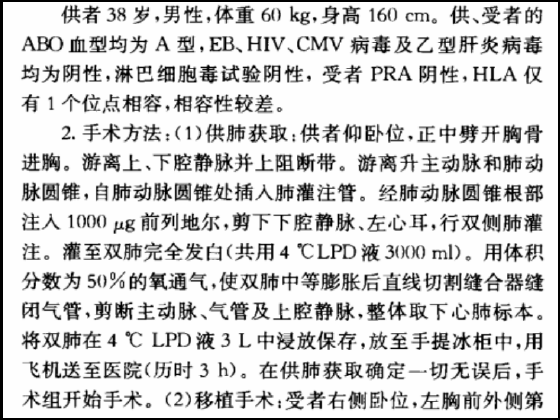
The research paper does not give a description of the donor’s cause of death. However, the physical exam and tests are comprehensively exhibited in the paper. The donor-recipient matching was completed within 14 days. It is evident that the donor had been selected, and the organ harvesting, transportation and transplantation were prearranged.
In addition, from 2003 to 2004, the First Affiliated Hospital of Xinjiang Medical University performed 3 liver transplants to treat fulminant hepatic failure (FHF)[145]. Fulminant hepatic failure would cause a series of serious syndromes within two weeks (of the onset of the illness). It has a rapid onset and can lead to quick deaths. As “the three patients were all in critical condition”, “rescue transplants” had to be performed within two weeks after the onset of fulminant hepatic failure. Where did the First Affiliated Hospital of Xinjiang Medical University so quickly obtain the donor livers from?
7.7 Multiple Transplants Performed Consecutively or Simultaneously
On Dec. 29, 2005, Foshan No.1 People's Hospital in Shandong Province simultaneously performed 7 kidney transplants[146].
From Dec. 28, 2004 to Dec. 29, 2004, in less than 24 hours, 5 kidney transplants and 2 liver transplants were performed in Foshan No.1 People’s Hospital[147].
From noon on April 25, 2002 to 2pm the next day, Shengli Oilfield Shengli Hospital, in Shandong Province, performed 6 kidney transplants in succession. A media report said, “This (series of) kidney transplants is the first, as well as the largest in scale, in the history of Shengli Oilfield and the history of Dongying City, Shandong Province”. The report said that on the day before the operations, “deputy director Kang Xinli, organized the urology and anesthesiology department staff to travel to another location to collect “donor” kidneys. They arrived at the hospital at 12 noon on April 25, despite the fatigue resulted from long-distance travel, upon returning to the hospital, the staff started to perform the surgeries[148].” It is evident that the donors’ emergence and the recipients’ selection were both pre-planned, and the organ harvesting was premeditated.
In addition, on Oct. 27, 2002, within 24 hours, Shengli Oilfield Shengli Hospital carried out 5 kidney transplants and one liver transplant. From Jan. 9 to Jan. 12, 2004, the hospital carried out 10 kidney transplants and one liver transplant. The hospital performed its first kidney transplant in Oct. 1999 and its first liver transplant in Oct. 2002[149].
During the May 1 public holidays in 2001, Jiang Hua, from the ophthalmology department of Jinan Military Region General Hospital, led his entire department to continuously perform corneal transplants. During the day, they went to other places to collect corneas, and in the evenings, they performed surgeries. They worked around the clock every day for the entire week[150]. This article published in 2009 says in the end, “Over the years, many holidays were spent in this way”. In “a lot of holidays”, they went to other places to collect corneas, and then they would immediately perform the transplants. This indicates that the corneas were freshly-cut, and they were not taken from any eye bank. Not to mention, “eye banks in China are basically in a state of zero inventory[151]”. Then, why during the “many holidays”, the donors would emerge? The hospital staff had to make a special trip to others places to collect corneas. This suggests that the whole process was premeditated. And there could not be only one pair of cornea harvested. It is highly likely that a certain CCP department is in charge of coordinating the distribution of live “donors,” and it often arranges the hospitals, with which it has connections, to go and harvest organs during the holidays.
On Dec. 27, 2007, Qu Qingshan, director of the kidney transplant center at Zhengzhou People's Hospital, completed 13 kidney transplants within 21 hours[152]. In an article published in February 2009, the hospital claimed that it completed “322 kidney transplants within 2 years, ranking the first in the entire country[153].”
In August 2000, Dongfeng General Hospital in Shiyan City, Hubei Province, simultaneously carried out “a series of large-scale organ transplant activities” composed of 10 kidney transplants, one parathyroid transplant and 3 corneal transplants, all on the same day[154].
The number of kidney transplant surgeries performed by Yue Zhongjin from Lanzhou University No. 2 Hospital ranks the first in Gansu Province. He has set the record for the highest number (of consecutively performed transplant surgeries) in Gansu Province by leading his entire department to continuously perform 8 kidney transplants within 32 hours[155].
8Organ Harvesting Happens Throughout China
The over 300 research papers were published after 2000. There were very few such papers prior to 2000. The papers discuss many different types of organ extraction, such as single organ extraction (liver, kidney, heart, lung, cornea, etc.) and multi-organ extraction (intraperitoneal cluster, liver-kidney, pancreas-kidney, heart-lung).
8.1 Organ Harvesting not Limited by Region, Happens in All Provinces
Categorize the papers based on the location of the hospital where the authors work, all 31 provinces and municipalities were involved. The chart below shows the number of hospitals in each province.
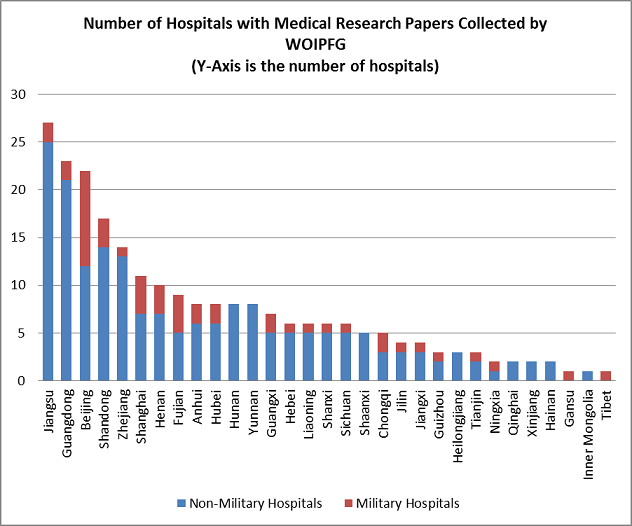
The chart below shows geographically, how the hospitals are located. The region with the most number of hospitals is southeast coast and some inland provinces.

8.2 Focusing on Tianjin No. 1 Central Hospital: Annual Average 600 liver transplants
As of 2004, Tianjin No.1 Central Hospital Orient Transplant Center performed 2,248 liver transplants, averaging 600 liver transplants and 300 kidney transplants every year. It was said that the liver transplant annual average was the highest in the world. In addition, the Transplant Center also helped 47 hospitals from 16 provinces to conduct over 300 liver transplants in total[156].
With the help from Tianjin No.1 Central Hospital, Beijing Armed Police Forces General Hospital performed over 220 liver transplants in 2005[157].
In 2004 alone, Tianjin No.1 Central Hospital conducted 507 liver transplants at its own premises and 300 liver transplants elsewhere. It amounts to 1/3 of the total liver transplants done in the country and broke the world record held by University of Pittsburgh Organ Transplant Center. In January 2005, 108 liver transplants and 43 kidney transplants were conducted. That is 4 to 5 liver transplant operations per day in a 5 day working week[158].
According to China Liver Transplant Registry, Tianjin No.1 Central Hospital and Beijing Armed Police Forces General Hospital jointly finished 6,270 liver transplants by 2010, which amounts to 30.2% of the national total. In addition, Tianjin No.1 Central Hospital also helped 66 hospitals from 22 regions, which amounts to 2/3 of the national total[159].
The paper below is an example of liver extraction done by Tianjin No.1 Central Hospital.
The paper published on April 2008 edition of Tianjin Nursing said, “from 2002 to 2006, 2,195 liver transplants were done, 2,500 livers were extracted from cadavers of brain-dead donors, all of whom tested negative in HIV, Syphilis, Hepatitis B and Hepatitis C[160].” This implies that the number of donors is greater than the number of liver extractions, which is bigger than the transplant number. Moreover, whether the organ is transplantable was determined after the “donor” was cut open and organ was exposed. The section titled “initial exam on donor liver” in the paper said the fatty livers can be determined by observing the color of the livers, “mid-level and above fatty livers will be discarded.” Note that at that time, the “donor” was opened up and the liver was not yet extracted.

After the livers were extracted, “mid-operation testing” was done to determine if the liver would be transplanted.

Even though the title of the paper mentioned “cadaveric livers,” all of the 2,500 livers had warm ischemia time of less than 10 minutes and the extraction time was under 30 minutes, the cold ischemia time was under 12 hours. Note that the paper said at the beginning that “extraction was done after brain death occurred.” It is likely that the “donor” was alive and well before liver extraction and the death was the result of organ extraction.
Tianjin No.1 Central Hospital also claims that from January 1999 to July 2005, 80 secondary liver transplants were done. Among these 80 cases, the period between first and secondary liver transplants for 14 cases were 1 to 7 days, 10 cases had wait time of 8 to 30 days, and 56 cases had a wait time of over 30 days[161]. That is to say, at least 24 cases had wait time less than 30 days.
8.3 Many Hospitals Conducted Large Numbers of Organ Extractions
The Chinese regime officially admitted that around 2006, there were about 650 hospitals doing human organ transplants. The table shows some hospitals that conducted large numbers of transplants.
Table 4. Hospitals with Large Numbers of Transplants
|
Hospital Name |
Time Period of Transplants |
Description of Organ Extraction and Transplant |
|
|
1 |
武汉大学中南医院 Zhongnan Hospital of Wuhan University |
2002-2012 |
407例供肝,“取自急性脑死亡和急性心死亡供者。热缺血时间平均(18+/-10)min[162]” |
|
2 |
第二炮兵总医院 The Second Artillery General Hospital of Chinese People’s Liberation Army, Beijing |
2004-2007 |
肝移植和供体切取103例[163] |
|
3 |
解放军第309医院(总参总医院) No.309 Hospital, People’s Liberation Army |
1988/12-2003/4 |
单纯肾脏摘取431例,肝肾联合摘取55例,胰-肾联合摘取10例,心肝肾联合摘取10例[164] |
|
4 |
辽宁省人民医院和中国人民解放军第463医院 Liaoning People’s Hospital & No.463 Hospital, People’s Liberation Army |
Until 2007 |
肝肾联合快速切取及分离近百例[165] |
|
5 |
武警总医院 Armed Police Forces General Hospital |
2002/5-2005/5 |
437例供肝快速切取以及修剪[166]。 |
|
6 |
南京八一医院 Nanjing No.81 Hospital, People’s Liberation Army |
2003/4-2006/5 |
该院实施103例供肝切取,采用单独肝脏灌洗切取或腹内脏器联合灌洗切取[167]。 |
|
7 |
解放军第303医院 No.303 Hospital, People’s Liberation Army |
2003/6-2005/6 |
该院实施联合切取供体肝、肾69例次,联合切取肝、肾、胰及十二指肠3例次[168]。 |
|
8 |
解放军第181医院 No.181 Hospital, People’s Liberation Army |
2006/10-2012/12 |
该院实施29例原位心脏移植和供体切取,供体男性脑死亡者,年龄20~39岁,平均(24.9±6.2)岁,供心热缺血时间5~8min[169]。 |
|
9 |
解放军第401医院 No.401 Hospital, People’s Liberation Army |
2003/9-2004/5 |
该院实施34例肝移植,供肝均为尸肝。供肝切取采用快速法。供肝热缺血时间为2-9min,平均5.1min[170]。 |
|
10 |
武警山西总队医院 Shanxi Armed Police Corps Hospital |
2004/10-2006 |
该院武警总医院合作共同完成的肝移植手术12例和供体切取,供肝均取健康男性严重颅脑外伤死亡者[171]。 |
|
11 |
武警宁夏总队医院 Ningxia Armed Police Corps Hospital |
2003/3-2005/8 |
该院实施肾移植51例,50例尸肾供体,供肾为尸体肾50例,年龄19~28岁,左供肾26例,右供肾24例,热缺血时间5~10分钟,平均6.5分钟,采用整块切取法[172]。 |
|
12 |
解放军第175医院 No.175 Hospital, People’s Liberation Army |
2003/5-2007/12 |
完成5例同种异体原位心脏移植和供体切取,供体为脑死亡男性,年龄24~48岁[173] 5 orthotopic heart transplants and extractions, “donors” were all brain-dead male, ages 24 to 48. |
|
13 |
天津第一中心医院 Tianjin No.1 Central Hospital |
2004/1-2008/8 |
1600例供肝切取[174] |
|
14 |
中山大学附属第三医院 Third Affiliated Hospital, Sun Yat-Sen University |
2001/4-2006/7 |
843例肝移植和切取[175] |
|
2008/1-2009/6 |
232例肝肾联合供体切取[176],男230例,女2例;年龄18~35岁。 |
||
|
15 |
复旦大学附属中山医院 Fudan University Affiliated Zhongshan Hospital |
2004/1-2006/8 |
117例肝肾联合快速切取,其中心肺肝肾联合切取5例,心肝肾联合切取6例[177]。 |
|
2000/5-2011/4 |
298例原位心脏移植,尸体供心291例,临床脑死亡7例,年龄18~45岁,平均(26.8±4.5)岁,其中男性283例,女性15例。均无明确心血管疾病或其他重大脏器疾病史[178]。 |
||
|
16 |
上海市第一人民医院 Shanghai No.1 People’s Hospital |
2001/1-2003/9 |
138例快速肝肾联合切取,尸体供肝者,男120例,女18例[179]。 |
|
2001/1-2010/4 |
561例肝移植,再次肝移植29例,供肝均取年轻无心跳供体,供体年龄19~36岁,平均(25.7±7.3)岁[180]。 |
||
|
17 |
宁波市鄞州第二医院 Yinzhou No.2 Hospital, Ningbo City |
1992/12-2010/4 |
该院实施肾移植1016例,最初40例,采用分侧取肾法,以后均采用原位灌注双侧联合取肾法,热缺血时间3~10min,平均6.2min[181]。 |
|
1992/12-2001/12 |
肾移植238例242例次和供肾切取,供者年龄19~49岁,35岁以下者占95.6%[182]。 |
||
|
18 |
中南大学湘雅三医院 |
2002/3-2005/12 |
107例供肝切取,均采用原位低温灌注整体器官切除法取肝[183]。 |
|
19 |
北京佑安医院 Beijing YouAn Hospital |
2005/5-2006/4 |
99例肝移植和供肝切取,均为尸体供者,年龄在50岁以下[184]。 |
|
20 |
北京大学人民医院 Peking University People’s Hospital |
2000/5-2006/5 |
6年间该院连续实施的供肝获取421例,供体采用腹部器官快速状体切取技术获取供肝[185]。 |
|
21 |
东方肝胆外科医院 Eastern Hepatobillary Surgery Hospital, Shanghai |
2003/4-2006/3 |
完成肝脏移植160例(160例次),其中全肝移植159例次和3例活体肝移植和供肝切取,采用快速肝肾联合切取法[186]。 |
|
22 |
广州医学院第二附属医院 Guangzhou Medical College No.2 Affiliated Hospital |
2001/4-2005/10 |
共切取供体肾脏458只[187]。 |
|
23 |
中山大学附属第一医院 The First Affiliated Hospital, Sun Yat-Sen University |
1998/4-2005/12 |
该院完成430例供肝切取[188]。2004年,该院实施186例快速供肝的切取和修整[189] |
|
24 |
福建医科大学附属协和医院 Fujian Medical University Affiliated Xiehe Hospital |
2002/4-2006/10 |
该院实施61例供心获取并行原位心脏移植[190]。截至2008年,该院实施111例供心切取[191]。 61 orthotopic heart transplants. Until 2008, 111 cases of heart extraction were performed. |
|
25 |
江苏省人民医院 Jiangsu People’s Hospital |
2004/10-2006/4 |
该院实施原位肝脏移植117例和尸体供肝,供肝均无肝脏基础疾病、恶性肿瘤及明显脂肪变性,乙型肝炎血清学检查阴性。采用腹主动脉和门静脉快速双灌注法获取供肝[192]。 117 cadaveric liver transplants, “donors” had no kidney and liver diseases, no malignant tumors, no obvious fatty liver syndrome, Hepatitis B tested negative. |
|
26 |
北京中医药大学东直门医院 Dongzhimen Hospital of Beijing University of Traditional Chinese Medicine |
2003-2007 |
该院实施112例同种异体供体切取[193]。 |
|
27 |
苏北人民医院 Subei People’s Hospital |
2000/1-2006/12 |
该院完成32例供体切取[194]。 |
|
28 |
山东省立医院 Shandong Provincial Hospital |
2005/3-2007/12 |
完成97例终末期肝病移植,两例急诊肝移植[195]。山东大学硕士论文27例急诊移植[196],硕士论文的导师是刘军,山东省立医院器官移植肝胆外二科主任医师。山东省器官移植学会副主任委员,山东省医师协会器官移植分会副主任委员,中华医学会器官移植学分会全国委员[197]。 97 liver transplants and 2 emergency liver transplants. A Shandong University master’s degree thesis was about 27 emergency liver transplants. The adviser was Liu Jun, chief surgeon at Shandong Provincial Hospital Organ Transplant Center. |
|
29 |
淮北市人民医院 Huaibei People’s Hospital |
2005/5/20 |
急性肝功能衰竭患者实施急诊肝移植,供肝热缺血时间为4分钟[198]。 |
|
30 |
北京朝阳医院 Beijing Chaoyang Hosptial |
1999/7-2004/12 |
实施164例肝移植和供体切取[199] |
8.4 Suspicious connection: Dongguan Taiping People’s Hospital, Kunming Kidney Hospital and Kunming Forensic Hospital
From January to October 2002, Dongguan Taiping People’s Hospital performed 59 combined liver-kidney transplants and 152 kidney transplants[200].
From August 2002 to August 2005, the same hospital performed 90 combined liver-kidney transplants and 260 liver transplants[201]. A mid-sized hospital in the mid-sized city of Dongguan, Guangdong Province was able to conduct at least 211 organ extractions in 10 months’ time in 2002 and more than 350 organ extractions from 2002 to 2005. Where did all those organs come from? The director of the Urology department, Li Jie participated in over 4,000 kidney transplants and over 50 liver transplants, was the main surgeon in over 500 kidney transplants and 12 liver transplants[202]. As of April 2008, Dongguan Taiping People’s Hospital Organ Transplant Center and Kunming Forensic Hospital in Yunnan province jointly conducted 1,537 kidney transplants[203].
Note that Kunming Forensic Hospital also has a Hemodialysis kidney transplant center[204], which used to perform paternity tests but started HLA testing since 2001. The Forensic evidence room of Kunming forensic hospital claims to have “conducted several thousand HLA testing from 2001 to 2008[205].”
Kunming Kidney Disease Hospital Yunnan Organ Transplant Center Branch, has attracted kidney transplant patients from “Hong Kong, Taiwan, Macao, Australia, Thailand, Indonesia, Malaysia, Singapore, Vietnam and others totaling over 10 countries and regions.” Kunming Kidney Disease Hospital’s online advertisement had a sectioned titled “advantages of our kidney transplants.” Below is the website screen shot captured in July 2007[206].

|
Advantages of our Kidney Transplants We are one of the earliest hospitals in China to start HLA matching and PRA, in order to select suitable donor organs for our patients. 1. we guarantee to find healthy kidneys suitable for every patient in the shortest time possible; 2. the donors were all tested of infectious diseases, such as HIV, Syphilis, Hepatitis B and Hepatitis C by national health organization; 3. We provide donor organs with the shortest warm ischemia time and cold ischemia time; 4. Our center preforms transplant operations every week and is the only transplant center in the country that matches donors to recipients; The above is to guarantee successful short term and long term transplant results. With good HLA matching the kidney transplant is more likely to be successful. Protecting Patients’ Rights If a patient is not in a transplantable condition, no operations will be forced upon the patient; prior to an operation the patient must go through PRA and HLA testing; if the donor organ is not in perfect condition, no operation will be done; as long as a doctor agrees to preform kidney transplant, he or she is confident that the operation will be successful; if not successful we will repeat the transplant operation until it is successful, and we do not charge for all the extra transplant operations; there is no age limit; all donor organs are equipped with full documentation of health condition, including liver and kidney function tests and HIV tests results; our patients use the state-of-the-art medications prior to the operation and the medical equipment used during the operation is the best in the country. Address: Guanshang Guanyu Street, Kunming, China Telephone: 0871-7269277 |
As stated in its advertisement, Kunming Kidney Disease Hospital “guarantee to find healthy kidneys suitable for every patient in the shortest time possible”, “provide donor organs with the shortest warm ischemia time and cold ischemia time”, “the only transplant center in the country that matches donors to recipients”, “if not successful we will repeat the transplant operation until it is successful”… Such confidence is possible only when there is a large donor bank available on demand.
Kunming Forensic Hospital and Kunming Kidney Disease Hospital share the same group of doctors. The executive director of Kunming Kidney Disease Hospital, Gao Wei also holds positions in Dongguan Taiping People’s Hospital and Kunming Forensic Hospital[207]. A summary of Gao Wei’s transplant experience is the following: from Jan. 2001 to Dec. 2002, participated in 605 kidney transplants, 43 kidney extractions and 8 combined kidney-liver extractions[208]. From Aug. 2002 to Aug. 2005, participated in 350 kidney transplants, among which 90 combined kidney-liver extractions and 260 kidney extractions[209]. As of April 2008, participated in 1,537 kidney transplants[210].
8.5Military and Armed Police Forces Hospitals Have Ample Organs, so Many They Even Provide Organs to Local Hospitals
Beijing Military Region General Hospital Liver Transplant Center started clinical liver transplant since 1999, claiming “liver transplant is a routine operation.” “We have established a fast and well-connected channel to obtain donor livers. We can obtain high quality donor livers not only from Beijing and surrounding areas, but also from other provinces and cities[211].”
On May 15, 2011, director of Guangzhou Air Force Hospital Department of Ophthalmology, Jing Lianxi visited Shanghai Bright Eye Hospital. Jing said that “Guangzhou Air Force Hospital, with our unique advantages, will provide high quality corneas to Shanghai Bright Eye Hospital[212].” The so-called “unique advantages” would be ample high quality corneas.
The ophthalmology department of Shenyang Military Region General Hospital has the largest eye bank in the military system and also in the Northeastern region[213]. It claims to have ample donor sources[214]. Shenyang Military Region General Hospital has the biggest number of corneal transplants performed within the Northeastern region. Moreover, it is the only hospital that can provide cornea on demand[215]. In March 2006, Liaoning Provincial Thrombosis Hospital of Integrated Chinese and Western Medicine was exposed internationally for harvesting organs, including corneas, from living Falun Gong practitioners. The regime denied the allegation saying that the hospital was too small and had no ability to perform transplantation. Having no ability to perform transplantation does not mean having no ability to extract organs, including corneas. The hospital is only 30km away from Shenyang Military Region General Hospital.
8.6 The Peak of Organ Extractions Coincides with the Peak of the Persecution of Falun Gong
The graph below shows the number of research papers with description of organ extraction taking place in certain time period. For example, over 130 papers mentioned organ extraction procedures took place in 2004.
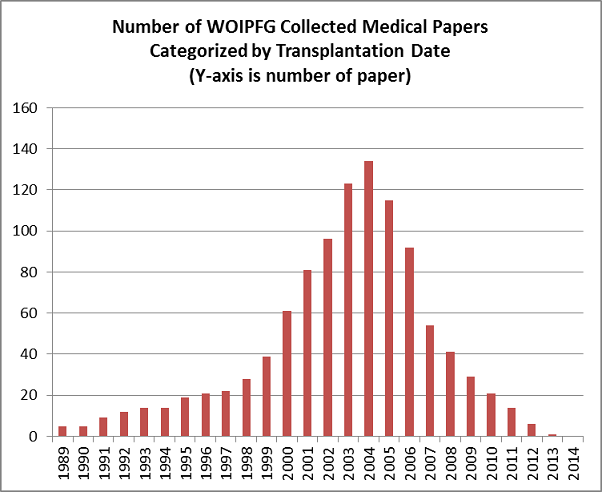
Even though this is incomplete statistics, it still shows the general trend of rapid increase after 2000, peaking between 2003 and 2005, and rapid decrease after 2006.
The rapid increase of research papers after 2000 coincides with the start of Chinese regime’s persecution of Falun Gong.
The rapid decrease in research papers after 2006 was very likely caused by the March 2006 exposure in the international community of state-sanctioned live organ harvesting in China. The Chinese regime adapted its live organ harvesting into a more stealthy operation, including silencing medical research papers. Note that the decrease after 2006 is decrease in medical research papers, not decrease in organ transplants performed.
8.7 The Case of Weifang City Shandong Province: Intensifying Persecution and Thriving Transplantation Business
The graph below shows the number of research papers, from hospitals in Shandong province, with description of organ extraction taking place in certain time period. There were zero research papers prior to 1999. Since 1999, the number of papers gradually increased. Then around 2002 and 2003 time frame, there was an explosive increase until it reached the peak in 2004. Such increase is implausible unless there was a sudden increase of “donor” organs.
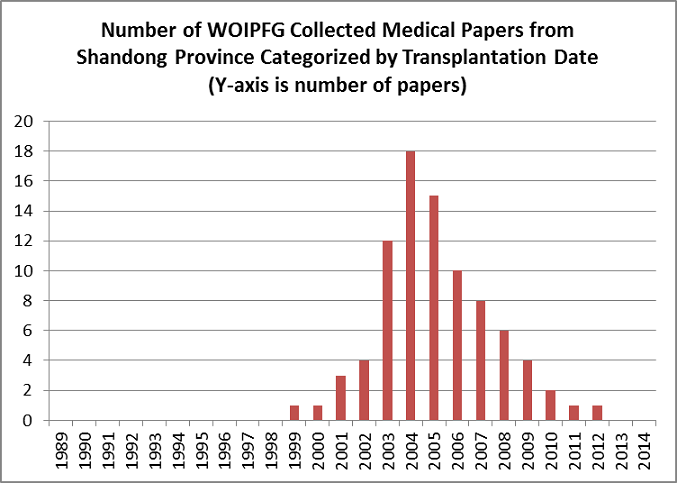
Take a mid-sized city in Shandong province, Weifang city, for example. According to minghui.org, a website documenting firsthand account of the persecution of Falun Gong in China, Weifang ranks number one in the severity of persecution among all mid-sized (prefecture level) cities in China. As of May 2014, there were at least 109 confirmed deaths due to the persecution[216]. The chart below shows the number of death per year. The peak happened from 2000 to 2005. Again, this trend coincides with the increasing number of organ extraction papers.
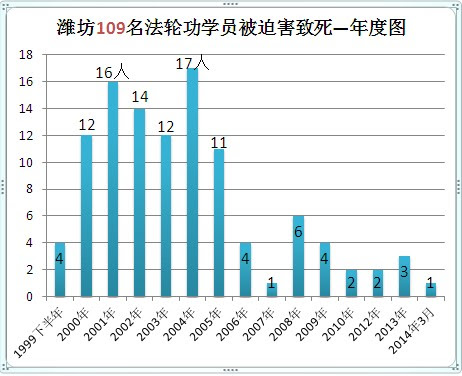
Caption: Number of Deaths by Year of 109 Falun Gong Practitioners Persecuted to Death in Weifang City
The development of cornea and kidney transplant in 3 Hospitals in Weifang
The ophthalmology department of Weifang Medical College Affiliated Hospital describes its growth on its website: “In 1979, the first formal eye bank was established in Weifang Medical College Affiliated Hospital. It has completed almost 10,000 corneal transplants. Through hard work, advertisement, and support from certain government agencies, the Hospital was able to broaden its cornea sources[217].”
Based on WOIPFG’s investigation, there are a few hospitals in China who claim to have conducted several thousand corneal transplants, namely, Sun Yat-Sen University Eye Center[218], Qingdao Eye Hospital[219], Shangdong Provincial Eye Hospital[220] and Weifang Medical College Affiliated Hospital.
Weifang Rende Hospital specializes in hemodialysis (血液净化) and kidney transplant. It is “the largest kidney disease treatment center in the city and the first to perform HLA testing in Shandong province.” The surgeons established “a network of organ supply system[221].” From 1998 to 2004, it has performed over 1000 HLA testing. “Being able to exchange and share matching data made it possible to meet the clinical needs for organs[222].”
Weifang Eye Hospital’s website claims: The corneal disease treatment center has the standard eye bank approved by Shandong provincial Department of Health. Since 1999, several thousand corneal transplants were performed. (The Center) has specialists such as Li Guiren, Zhang Shaobin, Zhang Haorun. Zhang Shaobin has conducted several thousand corneal transplants. Weifang Eye Hospital eye bank was recognized the only standard eye bank in Weifang city by Shandong provincial Department of Health, and can provide ample corneas for patients[223].
To summarize, Weifang Medical College Affiliated Hospital and Weifang Eye Hospital have performed over 10,000 corneal transplants since 1999. The corneas were mostly “fresh” ones. In 5 years’ time since 1999 to 2004, Weifang Rende Hospital has done over 1,000 cases of HLA testing. Where could a mid-sized city find so many donors? Moreover, all three hospitals mentioned “support and cooperation from certain government agencies,” “broadening the donor organ sources,” “having ample organs”, “establishing a donor supply system”, “sharing with other centers,” etc. With the persecution of Falun Gong became increasingly severe, the number of captive Falun Gong practitioners kept increasing, thus fueling the thriving transplantation industry in Weifang City.
9 Transplant Abnormalities Continue in China
After the live organ harvesting was exposed in 2006, the CCP has created a series of measures to conceal the real source of organs. For example, the Ministry of Health has designated specific transplant units, set up an organ donation system, admitted its long-standing use of organs from executed prisoners, guaranteed to not use condemned prisoners’ organs from a certain date onwards, reported organ black market individual cases of arrests, exaggerated the illusion of a rampant organ black market with individual cases, and so on. At the same time, hospitals of different sizes would claim that due to a lack of donors, they have to reduce the number of organ transplants, and so on.
However, the abnormal phenomena in Chinese transplantation industry are still ongoing.
9.1Qingdao University Founded an Organ Transplant Center and “Planned to Complete 100 Operations within the First Year”
In February 2014, the Affiliated Hospital of Qingdao University announced the establishment of an organ transplant center. The hospital’s personnel “travelled to Beijing multiple times to cordially invite” the former deputy director of the Armed Police Forces General Hospital Liver Transplant Institute, Zang Yunjin, to form “a transplant elite team of 20 to 30 people” and to set up “liver transplant, heart transplant, kidney transplant and pancreas transplant sections”. Also, the hospital planned to complete 100 organ transplants within the year” [224]. However, previously, the hospital only carried out 40 kidney transplants and 3 to 5 liver transplants every year; and it was not capable of performing heart transplant operations. If there were no specific organ sources, how could the hospital accomplish its ambitious plan of performing100 transplants?
An article published in August 2014 has proven that the “full confidence” of the Affiliated Hospital of Qingdao University was not empty talk. It was reported that “after the center was established, in less than 6 months, the hospital had carried out 30 liver transplants and 38 kidney transplants, ranking first in the province in terms of the total number of surgeries performed and the operations’ quality was leading in the country.” The report also said, “How big the hearts are, how big the stage is.”
Zang Yunjin serves as the director of the organ transplant center and the director of the liver transplant department. Zhang Bin and Zhang Shun serve as deputy directors of the center and the liver transplant department. The liver transplant team’s other members include Fan Ning, Hu Weiyu, Hu Xiao, Guan He and Wang Xin. The former deputy director of Qianfoshan Hospital’s cardiac surgery department, Li Zhiqiang, is hired as the director of the kidney transplant department. Dong Zhen serves as the deputy director of the kidney transplant department. “Sun Lijiang and Li Yanjiang from the hospital’s urology surgery department, to support the kidney transplant department in achieving a new leap forward, often rushed to Huangdao District in the evenings to assist with the surgeries, after completing their own work. Together with Dong Zhen and Huang Tao, they have set a record of completing 6 surgeries within 24 hours[225]!”
9.2 Five donor livers “Simultaneously Arrived” at the Fuzhou General Hospital of Nanjing Military Region; Transplant Operations were Completed within 17 Hours
From 12 a.m. on February 18, 2014 to 4:00 a.m. on February 19, the Fuzhou General Hospital of Nanjing Military Region completed five liver transplants[226].
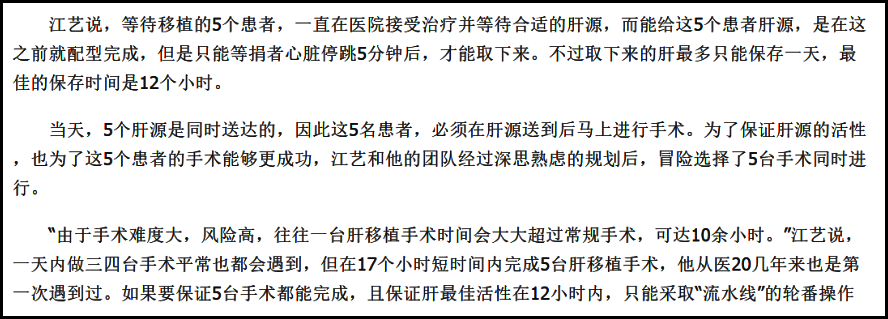
There were five patients waiting for livers to arrive in the hospital, and these five livers “had completed the matching process before arriving here, but they could only be harvested five minutes after the donors hearts stop beating.” Obviously, when the matching process was taking place, the five “donors” were still alive, and they were living persons with normal liver functions and a successful organ matching. Therefore, when the patients were at the hospital, instead of waiting for a suitable organ matching, they were waiting for the deaths of the “donors.” It is inconceivable that all five “donors” would have their “hearts stop beating” on the same day, and these five livers would “simultaneously arrive” at the Fuzhou General Hospital of Nanjing Military Region.
Who were these five “donors”? What caused them to die at the same time? This incident occurred in February 2014, clearly showing that amid the international community’s condemnation, while the Chinese Communist Party was promising to stop using the organs from executed prisoners, and denying its organ harvesting practice from living Falun Gong practitioners, at the same time, these premeditated crimes of murdering for organs are still taking place in China, and they were also openly reported by the state-run media.
Conclusion
After analyzing a group of Chinese medical research papers, this report presents the following conclusions:
Almost all organs used for transplantation in mainland China are removed from “brain-dead patients” or patients with “traumatic brain injuries” or persons whose “hearts just stopped beating”. These organs are all considered illegally harvested from living people.
Of the so-called “donors”, who had their organs harvested, more than 90% were healthy young adult men of 20 to 40 years old. During their life time, they were physically fit with properly functioning internal organs; they had no hepatitis B, HIV, syphilis or any other infectious diseases, and no history of alcohol and tobacco use. This group of people supplied organs to the tens of thousands of transplants taking place in mainland China every year. It is absolutely impossible to get these organs from executed prisoners alone. The illegally detained Falun Gong practitioners are the live “donors,” whose organs were taken without consent to support the ever-growing transplant needs.
In mainland China, there is a large living “donor” bank. When a “donor’s” profile matches that of a recipient, the “donor” would be put to death in the process of organ harvesting at a predetermined time. This is the only explanation for the ultra-short wait time for transplant operations, the emergency transplants, and the transplants with preselected dates.
This report analyzes the organ transplant research papers published on Chinese medical journals. The analysis results suggest that a large proportion of the organ “donors” were still alive when their organs were being removed. The research papers’ descriptions of the organ harvesting processes and the numbers of “donors” can at least partially exclude the possibility that some “donors” were executed prisoners. However, the large number of illegally abducted and detained Falun Gong practitioners seem to be the most plausible main source of living “donors.”
References
WOIPFG retains backups of all references. If any referenced websites were deleted, WOIPFG can provide a copy. English translation of references will be updated soon.
[1]《中国器官移植网》2013年3月7日 “九成医生尚不了解脑死亡 黄洁夫认为相关立法条件未成熟”
[2]《中国脑血管病杂志》2009年4月18日第6卷第4期 “脑死亡判定标准成人修订稿
[3]《中华神经科杂志》2013年9月第46卷第9期:脑死亡判定标准与技术规范(成人质控版)
[4] 《中华人民共和国国家卫生和计划生育委员会官方网站》
[5] “Maximum tolerable warm ischaemia time in transplantation from non-heart-beating-donors”
http://www.academia.edu/2517011/Maximum_tolerable_warm_ischaemia_time_in_transplantation_from_non-heart-beating-donors
[6]《都市快报》2013年1月14日 19人捐出器官改变了53人命运
[7]《人民网》2012年02月23日“器官捐献遇困境:两头热中间冷 受死亡标准制约”
[8] 《新华网》2004年5月3日 “卫生部:首个脑死亡标准出台的新闻与事实不符”
[9]《新华网》2005年08月13日“卫生部器官移植中心10月挂牌”
[10]《腾讯网新闻》2014年8月22日 “我国脑死亡立法空白90%医生不清楚鉴定标准”
[11]《中华医学杂志》2004年1月17日第84卷第2期 89~92页 “论自愿无偿器官捐献与脑死亡立法” 作者:陈忠华、袁劲
[12]《护士进修杂志》2009年9月第24卷第18期 1672~1673页 “心肺联合移植供体心及肺采集的手术配合”
[13] Report of 4 cases of total orthotopic cardiac transplantation
[14] 论文题目:原位心脏移植手术的体外循环管理
[15]《羊城晚报》2006年7月25日文章 首例脑死亡患者供体肺成功移植
[16] 论文题目:同种异体原位心肺联合移植的手术配合
[17] 论文题目:HTK液应用于心脏移植供心保护(附5例报告)南京军区福州总医院
HTK solution applied for donor preservation in 5 cases of heart transplantation
[18]《中国器官移植网-家庭保健报》2011年9月6日“面对选择器官捐献:用另一种方式活着”
[19]《全球财经中文网》2012年5月25日“中国器官捐献制度深陷困境”
[20] 论文题目:原位心脏移植5例报告
[21] OrganTransplant, Jul 2010, Vo.l 1, No. 4 “国际标准化脑死亡供肺的临床应用 3例报告”
[22]《人民网》2006年7月11日“我国首例心脏捐献移植成功--供体来自我国第18例脑死亡器官捐献者
[23]《羊城晚报》2006年7月25日文章“首例脑死亡患者供体肺成功移植
[24] 论文题目:穿透性角膜移植术治疗中晚期圆锥角膜疗效分析
[25] 论文题目:深低温长期保存角膜穿透移植术后角膜内皮分析
[26] 论文题目: (QINGHAI MEDICAL JOURNAL)“光学角膜移植的临床研究”
[27] 论文题目: GUIZHOU MEDICAL JOURNAL 角膜移植11例报告
[28] 论文题目: INTERNATIONAL JOURNAL OF OPHTHALMOLOGY“角膜移植术后排斥反应的防治探讨”
[29] 论文题目: JOURNAL OF MUDANJIANG MEDICAL COLLEGE “大植片穿透性角膜移植排斥反应中西医结合临床研究”
[30] 论文题目: CHINESE JOURNAL OF PRACTICAL OPHTHALMOLOGY“低温保存羊膜联合带干细胞全角膜板层移植治疗眼化学伤临床观察
[31] 论文题目:JOURNAL OF CLINICAL REHABILITATIVE TISSUE ENGINEERING RESEARCH
深板层角膜移植与穿透性角膜移植视力恢复的差异
[32] 论文题目: GUANGDONG MEDICAL JOURNAL 角膜移植术216例临床体会
[33] 论文题目: JOURNAL OF HENAN UNIVERSITY OF SCIENCE & TECHNOLOGY (MEDICAL SCIENCE))
“穿透性角膜移植术180例临床研究”
[34] 论文题目:“穿透性角膜移植83眼的临床观察
[35] 论文题目: Chinese Journal of ocular trauma and occupational eye disease“穿透性角膜移植术后干眼的分析”
[36] 论文题目:穿透性角膜移植治疗圆锥角膜的疗效观察
[37] 论文题目: TODAY NURSE 穿透性角膜移植患者的护理
[38] 论文题目: INTERNATIONAL JOURNAL OF OPHTHALMOLOGY 角膜移植术后排斥反应的防治探讨
[39] 论文题目: Clinical Journal of Medical Officer 穿透性角膜移植100例临床分析
[40] 论文题目:CHINESE JOURNAL OF PRACTICAL OPHTHALMOLOGY 穿透性角膜移植的内皮细胞变异分析
[41] 论文题目: CHINESE JOURNAL OF PRACTICAL OPHTHALMOLOGY“角膜移植300例临床观察”
[42] 论文题目: JOURNAL OF LINYI MEDICAL COLLEGE 深低温长期保存角膜行穿透性角膜移植术的临床观察
[43] 论文题目: CHINESE JOURNAL OF PRACTICAL OPHTHALMOLOGY 穿透性角膜移植术128例临床分析
[44] 论文题目: CHINESE JOURNAL OF OCULAR TRAUMA AND OCCUPATIONAL EYE DISEASE 儿童穿透性角膜移植联合白内障手术临床研究
[45] 论文题目: Chinese Journal of ocular trauma and occupational eye disease 穿透性角膜移植术治疗角膜溃疡穿孔
[46] 论文题目: CHINESE JOURNAL OF OCULAR TRAUMA AND OCCUPATIONAL EYE DISEASE
“深板层角膜移植与穿透性角膜移植治疗圆锥角膜的比较”
[47]论文题目:CHINESE JOURNAL OF OCULAR TRAUMA AND OCCUPATIONAL EYE DISEASE“感染性角膜炎的角膜移植术”
[48]论文题目:ZHEJIANG MEDICAL JOURNAL 穿透性角膜移植术41例临床分析
[49] 论文题目: JOURNAL OF CLINICAL OPHTHALMOLOGY 穿透性角膜移植术52例临床报告
[50] 论文题目: CHINESE JOURNAL OF PRACTICAL OPHTHALMOLOGY 闭合式小切口手法碎核折叠式人工晶体植入联合穿透性角膜移植术
[51] 论文题目: MEDICAL JOURNAL OF THE CHINESE PEOPLE'S ARMED POLICE FORCES“穿透性角膜移植119例”
[52] 论文题目: JOURNAL OF CLINICAL OPHTHALMOLOGY “穿透性角膜移植术临床分析”
[53]论文题目:“原位心脏移植术中供心保护的护理配合”
[54] 论文题目:原位肝移植5例
[55] 论文题目:心脏移植术后抗排斥反应治疗
[56] 论文题目: CHINA MODERN MEDICINE “肝移植术后胆道并发症的处理措施”
[57] 论文题目: JOURNAL OF SURGERY CONCEPTS & PRACTICE“肝移植初期连续成功10例报告”
[58] 论文题目:ACTA ACADEMIAE MEDICINAE NANTONG)“原位心脏移植4例体外循环分析”
[59] 论文题目: MODERN MEDICAL JOURNAL “尸体肝肾联合获取技术的改进及应用”
[60] 论文题目:CHINESE GENERAL PRACTICE) “手术方式对肝移植围术期肝功能影响”
[61]论文题目:SHANGHAI MEDICAL JOURNAL “231例240次肝移植手术方式回顾分析”
[62]论文题目:四例同种异体原位心脏移植初步经验总结
[63] 论文题目:原位心脏移植术后早期血流动力学监测及护理
[64]论文题目:CHINESE JOURNAL OF HEPATOBILIARY SURGERY“200例尸体供肝快速切取技术要点分析”
[65]论文题目: CLINICAL MEDICINE OF CHINA“移植胰腺术后急性胰腺炎的诊治”
[66] 论文题目:手术方式对肝移植围术期肝功能影响
[67] 论文题目:无心跳供者肝肾联合切取的技术改良和临床应用
[68] 论文题目:原位肝移植30例临床观察
[69] 论文题目:3例供心保护时间较长的原位心脏移植
[70] 论文题目:原位心脏移植51例临床经验”
[71] 论文题目:同种异体原位肝脏移植术治疗终末期肝病43例
[72] 论文题目:原位心脏移植治疗终末期心脏病25例临床分析
[73]论文题目:肝肾联合移植六例临床分析
[74] 论文题目:同种异体原位肝脏移植术的临床应用研究(附9例报告)
[75] 论文题目:单肺移植同期行心内缺损修补术一例
[76] 论文题目:脑死亡无偿器官捐献心脏移植二例
[77] 论文题目:同种异体原位肝移植中免疫抑制剂的应用(附1例报告)
[78] 论文题目:肝脏移植治疗肝癌的价值--附巨大肝癌肝脏移植一例报道
[79] 论文题目:298例原位心脏移植受者远期疗效分析
[80] 论文题目:肝移植供肝切取与修整技术
[81] 论文题目:终末期冠心病原位心脏移植一例
[82] 论文题目:肺移植供肺获取100例:冷缺血时间>6h及肺减容对预后的影响
[83] 论文题目:原位肝脏移植术后胆道并发症的诊治
[84] 论文题目:原位肝移植围手术期处理的体会
[85] 论文题目:原位心脏移植围手术期的处理(附6例报告)
[86] 论文题目:尸体肝肾联合获取技术的改进及应用
[87] 论文题目:全心脏原位移植(附4例报告)
[88] 论文题目:肝肾联合获取方法总结
[89] 论文题目:原位肝移植5例报告
[90] 论文题目:同种异体原位心脏移植二例
[91] 论文题目:原位肝移植5例
[92] 论文题目:联合切取尸体肝肾供体手术方法的改进
[93] 论文题目:肝动脉变异与肝移植
[94] 论文题目:原位肝移植供肝动脉变异的修整与重建
[95] 论文题目:肝移植供肝修整的经验
[96] 论文题目:供肝切取与保存技术中几个关键环节的探讨
[97] 论文题目:同种原位心脏移植26例
[98] 论文题目:亲属活体供肾移植与尸体供肾移植临床疗效的比较
[99] 论文题目:腹腔镜及开放供肾切取术后供者生活质量随访研究
[100] 论文题目:三种不同术式原位肝移植的临床研究
[101] 论文题目:二例原位心脏移植成功的体会
[102] 论文题目:晚期肝硬化行肝移植术12例体会
[103] 论文题目:同种原位心脏移植二例报告
[104] 论文题目:四例同种异体原位心脏移植初步经验总结
[105] 论文题目:同种异体原位肝脏移植13例次临床经验
[106] 论文题目:自制快速肝肾联合灌注系统灌注、切取技术及其临床应用
[107] 论文题目:肝移植术后神经系统并发症的防治分析
[108] 论文题目:清远市不同人群艾滋病、梅毒、丙型肝炎、乙型肝炎感染状况调查
[109] 论文题目:清远市监狱服刑人员艾滋病, 乙型肝炎, 丙型肝炎和梅毒感染情况调查
[110] 论文题目:监狱饮服岗位服刑人员乙型病毒性肝炎调查及预防对策
[111] 论文题目:某市在押人员乙型肝炎病毒感染调查
[112] 论文题目:三类人群艾滋病、梅毒、乙肝、丙肝检测结果报告
[113] 论文题目:三类人群艾滋病、梅毒、乙肝、丙肝检测结果报告
[114] 《河北省血液中心》配型中心
[115] 《大连市血液中心》血型研究室简介
[116] 《江西省血液中心》中心简介
[117] 《中国造血干细胞捐献者资料库广东省管理中心》深圳市血液中心免疫遗传研究室简介
[118] 《你我他》北京市红十字血液中心HLA研究室简介
[119] 《西安交通大学》卫生部法医学重点实验室
[120] 《西安交通大学第一附属医院》肾移植科简介
[121] 《西安交通大学第一附属医院》肾移植科简介
[122] 《西安交通大学第一附属医院》肾移植科的学科文化及团队精神
[123] 论文题目:同种异体原位心脏移植的体会The Experience of Homologuous Orthotopic Heart Transplantation
[124] 《腾讯网新闻》2014年8月22日 “我国脑死亡立法空白90%医生不清楚鉴定标准”
[125]论文题目:心脏移植供心采集的手术配合
[126]论文题目:心肺移植供体心肺保护1例
[127]论文题目:同种异体肾移植术245例的手术配合
[128]论文题目:313例成批同种异体肾移植术手术配合的组织与管理
[129]论文题目:肾移植术后红细胞增多症的中西医综合治疗(附82例报告)
[130] 论文题目:移植肾动脉栓塞二例报告
[131]《解放军第281医院》医院简介
[132]《西安高新医院》2012年9月5日 “10年的记忆”作者:张刘勇
[133] 论文题目:重型肝炎急诊肝移植的预后影响因素及处理
[134] 论文题目:急诊肝移植救治良性终末期肝病46例经验分析
[135] 郑州人民医院肝脏移植肝胆胰腺外科科室介绍
[136]论文题目:原位肝移植10例报告
[137] 论文题目:急诊肝移植治疗急性肝功能衰竭22例的临床分析”
[138]论文题目:肝移植术肝动脉重建问题(附17例报告)
[139]《中国人民解放军第八一医院》医生介绍王轩
[140] 论文题目:急诊肝移植术治疗食管曲张静脉破裂出血
[141]《新浪网》2003年4月1日 “西藏军区总医院成功实施高原首例肾移植”
[142] 论文题目:再次肝移植临床分析
[143] 论文题目:胰肾联合移植治疗1型糖尿病合并终末期肾病1例报告并文献复习
[144] 论文题目:同种异体单肺移植一例报告
[145]论文题目:肝移植治疗暴发性肝功能衰竭3例临床观察
[146] 《佛山市第一人民医院》泌尿外科同时完成7台肾移植手术
[147] 《佛山市第一人民医院》2005年1月6日 “他们让“感动”流芳”
[148]《当代健康报》2002年6月20日 “一天连做六例肾移植手术”
[149] 《百度百科》胜利油田中心医院
[150] 《中国医师协会》第三届中国医师奖蒋华简介
[151] 《搜狐健康》2014年6月5日“国内眼角膜库基本0库存 医学生带头加入捐献队伍”
[152] 《华夏礼仪培训网》2010年4月8日“医护礼仪培训--郑州人民医院服务旗帜与品牌风范”
[153] 《人民网》2009年02月13日郑州人民医院调查
[154] 《东风总医院》器官移植乳腺外科简介
[155] 《好大夫在线》岳中瑾大夫简介
[156] 《东方器官移植中心》 2006年1月5日“2005年中心年终总结大会”
[157] 《东方器官移植中心》2006年5月27日“全国第三届器官移植超声诊断新技术研讨会”
[158] 《新华网》2005年2月7日报道作者:林树文、张晓辉
[159] 《天津市第一中心医院》沈中阳简介
[160] 论文题目:原位肝移植尸肝切取的手术配合
[161] 论文题目:再次肝移植80例临床报告
[162] 论文题目:64例脂肪变性供肝临床肝移植疗效分析
[163] 论文题目:手术方式对肝移植围术期肝功能影响
[164] 论文题目:志愿者尸体胸腹部大器官联合摘取506例
[165] 论文题目:供体肝肾联合快速切取及分离的方法
[166] 论文题目:提高供肝灌注切取质量减少肝移植手术后胆道损伤并发症
[167] 论文题目:肝后腔静脉成形术行原位肝移植103例”
[168] 论文题目:腹部多器官联合切取的临床研究(附72例报告)
[169] 论文题目:29例原位心脏移植近期疗效报告
[170] 论文题目:同种异体肝移植围手术期的处理
[171] 论文题目:晚期肝硬化行肝移植术12例体会
[172] 论文题目:同种异体肾移植临床体会
[173] 论文题目:同种原位心脏移植5例报告
[174] 论文题目:供肝快速切取术中应注意的相关问题分析
[175] 论文题目:不同切取方法对肝移植供肝动脉解剖变异的损伤分析
[176] 论文题目:肝肾联合供体快速切取失误及其防范
[177] 论文题目:供体肝肾联合快速获取方法的改进及临床研究(附117例报告)
[178] 论文题目:298例原位心脏移植受者远期疗效分析
[179] 论文题目:改良法快速肝肾供体联合切取的探讨
[180] 论文题目:再次肝移植临床分析
[181] 论文题目:同种异体肾移植1016例次临床分析
[182] 论文题目:同种异体肾移植242例次分析
[183] 论文题目:肝动脉变异与肝移植
[184] 论文题目:改进供肝处理方法减少肝移植术后早期胆道并发症
[185] 论文题目:421例同种原位肝移植肝动脉重建体会
[186] 论文题目:肝移植中肝动脉重建及其并发症的处理
[187] 论文题目:两种供体肾脏切取手术方法的比较研究
[188] 论文题目:肝移植中肝动脉变异的重建
[189] 论文题目:快速供肝切取与修整的外科技巧
[190] 论文题目:61例心脏移植术的供心获取
[191] 论文题目:原位心脏移植111例供心保护的探讨
[192] 论文题目:原位肝脏移植术后胆道并发症的诊治
[193] 论文题目:丹参及冬虫夏草制剂在肾移植中应用的临床研究
[194] 论文题目:肝脏移植受体手术与外科相关并发症防治
[195] 论文题目:2例ABO血型不相容肝移植患者急诊术后并发症的观察与护理
[196] 论文题目:27例急症肝移植临床报告
[197] 《山东肝移植网》刘军简介
[198] 论文题目:急性肝移植治疗急性肝功能衰竭伴腹腔感染1例报道并文献复习
[199] 论文题目:再次肝移植的原因与手术时机的选择
[200] 论文题目:肝肾联合切取对移植肾质量的影响和技术探讨
[201] 论文题目:无心跳供者肝肾联合切取的技术改良和临床应用
[202] 《广东省东莞市太平人民医院》李杰简介
[203] 论文题目:高度致敏受者行肾移植术的临床研究
[204] 《互动百科》昆明法医院
[205] 《昆明法医院司法鉴定中心》专家简介帅莉
[206] 《明慧网》调查线索:在东南亚活跃招揽客户的大陆肾移植医院
[207] 《全球医院网》云南肾脏病医院
[208] 论文题目:移植肾功能延迟恢复的原因分析及其预防
[209] 论文题目:无心跳供者肝肾联合切取的技术改良和临床应用
[210] 论文题目:高度致敏受者行肾移植术的临床研究
[211] 《北京军区总医院肝胆外科》2009年02月25日“北京军区总医院肝移植中心简况”
[212] 《上海普瑞眼科医院官网》2011年5月21日“广州空军医院眼科主任景连喜教授莅临我院交流考察”
[213] 《沈阳军区总医院》特色技术角膜移植
[214] 《沈阳军区总医院》眼科学术带头人高明宏
[215] 《沈阳军区总医院》特色技术角膜移植
[216]《明慧网》2014年5月28日,“山东潍坊市109位法轮功学员被迫害致死”
[217] 《潍坊医学院附属医院》眼科简介
[218] 《中山大学中山眼科中心》角膜病专科
http://www.gzzoc.com/ylfw/lcks/jmbk/
[219] 《青岛眼科医院》角膜病科 科室简介
http://www.sdeyei-h.edu/department/1
[220] 《山东省眼科医院》医院简介
http://www.sd-eh.com/about.asp
[221] 《互动百科》潍坊仁德医院
[222] 论文题目:HLA组织配型在PRA阳性受者肾移植中的应用
[223] 《潍坊眼科医院》角膜病治疗中心简介
[224] 《青岛日报》2014年2月26日“青岛大学附属医院成立器官移植中心—国内顶尖专家担纲常驻可做四类器官移植手术”
[225] 《青岛大学附属医院》2014年8月5日,“攀登永不止步打造国内一流的器官移植中心”
[226]《中国器官移植网》转载《东南快报》 2014年3月10日“17小时不眠不休完成5台肝移植手术”


